Suzanne Keen: Where’d She Go?
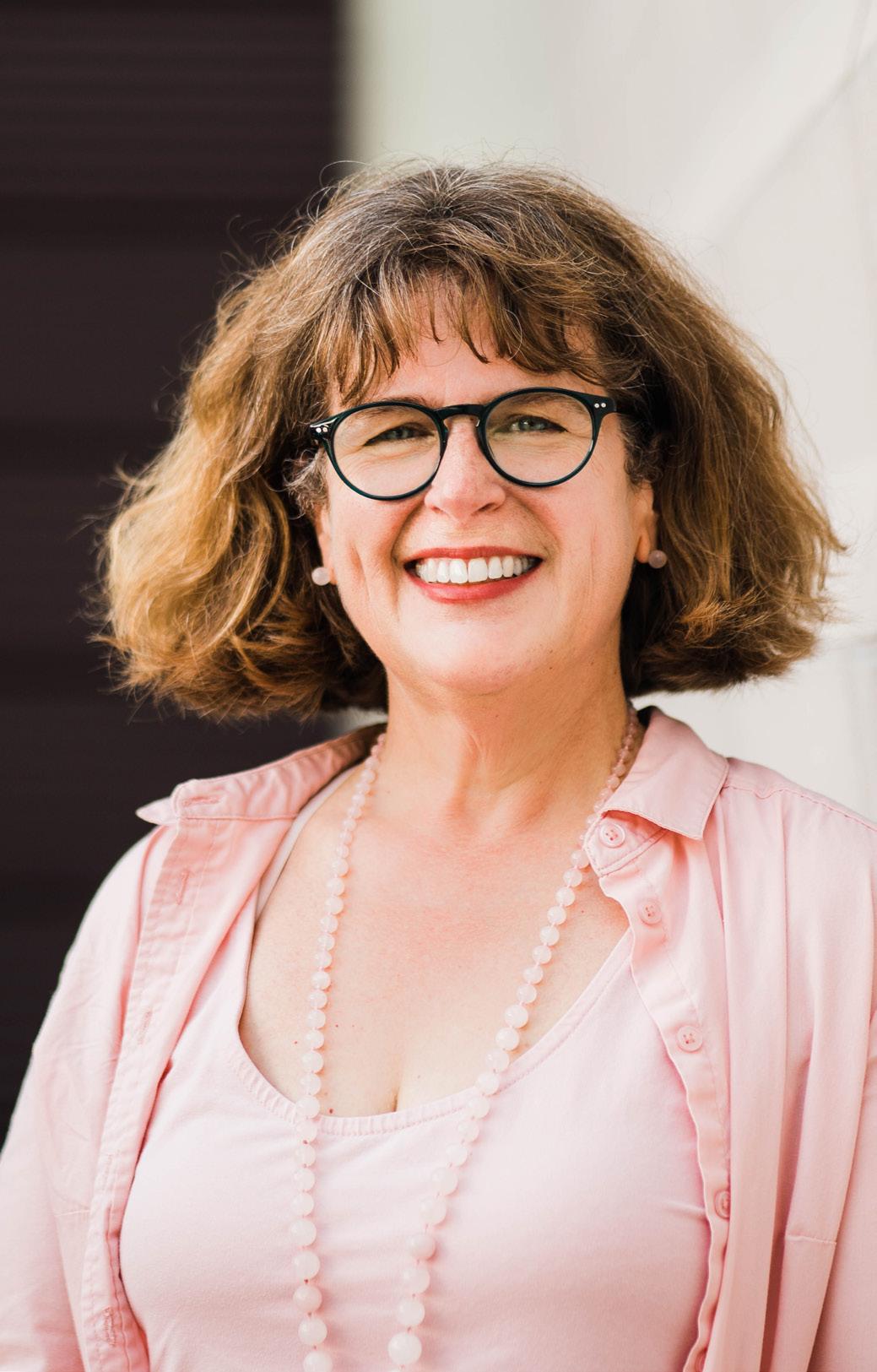
President for a comment during the week following the news, they declined and referred TSV reporters back to the email announcement.
In addition to this, a member of the English department was unable to provide further commentary due to the lack of knowledge about Keen’s eventual return amongst the faculty and staff. Since the college cannot provide students with any more clarity, the student body must find comfort in the reinstigation of authority following the quick transition of Marcus-Newhall from Acting President to official President of Scripps College.
By Belen Yudess ‘25 and Juliette Des Rosiers ‘26
Social Media Manager and Copy Editor Intern
OnMarch 20, the Scripps student body was notified about the resignation of Scripps President Suzanne Keen and the appointment of Vice President for Academic Affairs and Dean of Faculty Amy Marcus-Newhall as Acting President. After only eight months in office, Keen cited her decision to to spend more time with her elderly father as well as her desire to return to the classroom as her rationale behind this transition. It later came to light that former President Keen would return to Scripps as a tenured English professor in the fall of 2024.
Following the news of this abrupt resignation, many students, faculty, and staff were thrown by this decision. Marcus-Newhall also felt caught off guard by this announcement and acknowledged the bi-
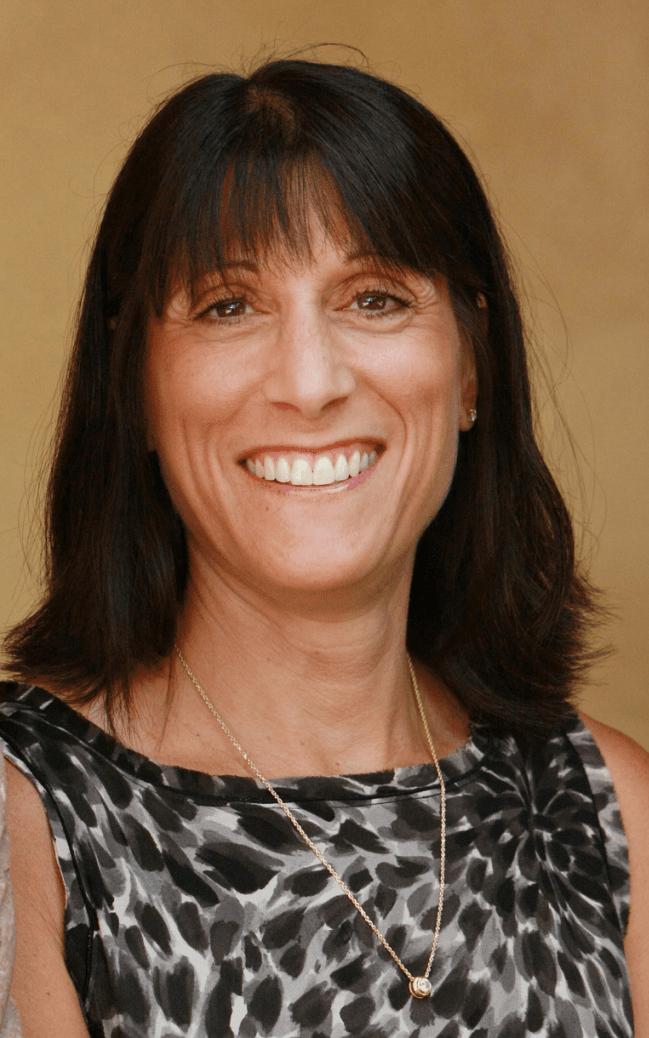

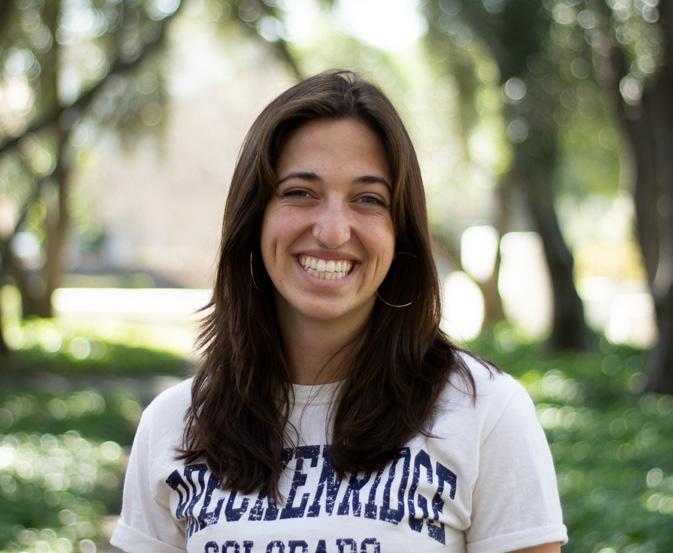
zarre nature of the situation. “I was surprised because this was unanticipated," she said. "It is unusual for a president to leave after such a short term in office and in the middle of the year,” she said.
Immediately after the email, speculations grew around campus as students whispered about why Keen’s departure was announced effective immediately. Many believed that the communication was lackluster and not completely transparent.
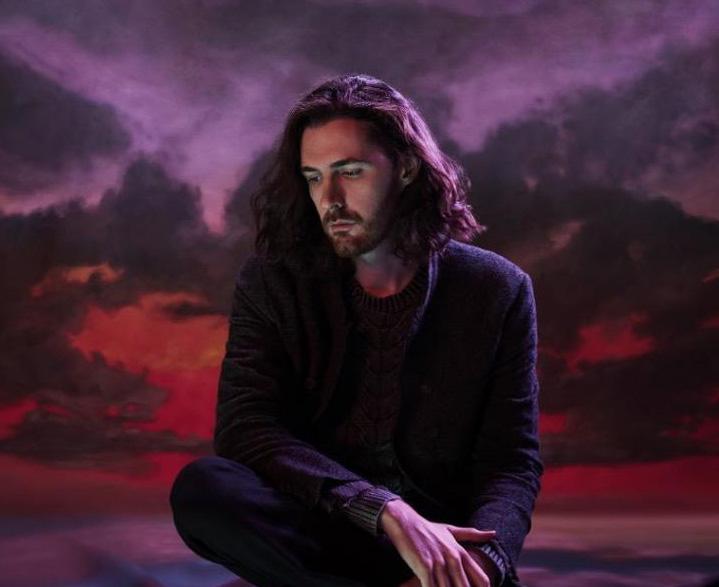

Although others in the Scripps community viewed the resignation as suspicious, Marcus-Newhall affirmed that, in her opinion, there would be no detrimental effect on the image of Scripps College. “Scripps is in great shape,” she said. “The college is more than any president. I'm not going to say it's positive that she departed, but I think it has a short-lived negative impact. My appointment as president conveys that the college has all of these wonderful initiatives, is in
great shape financially, has superb students, and exceptional faculty and staff. I see it as a blip as opposed to anything more than that.”
Due to the large amount of conjecture and concern regarding the resignation, Marcus-Newhall and the new Vice President for Student Affairs and Dean of Faculty, Sha Bradley, invited students to an open conversation on April 3 to pose any questions. Although it was a lively discussion, Marcus-Newhall emphasized that she could not provide further insight on the decision as that process was privy to Keen and the Board of Trustees.
“All I have is what was relayed to our community and I don't have any other information to share on this,” she said. “It's a Board of Trustees process, so I wasn't involved.”
While investigating the communication of Keen’s resignation, it became apparent to The Scripps Voice (TSV) reporters that MarcusNewhall’s words ring true. When TSV approached the Office of the

Marcus-Newhall does not see the role of president as the sole arbiter of the college, but rather someone who enhances the mission and supports the already existing administration. “Organizations need somebody to facilitate work,” said Marcus-Newhall. “At some point, decisions need to be made for a college, and that's what a president does. The president's job is to take an overarching perspective on every element of the college and to try to strategize as best as possible while not being in the weeds. We have a phenomenal senior team with many who have been here for a significant amount of time.”
In this new position, Marcus-Newhall will take over initiatives started and supported by Keen. Supporting the faculty revision of the Core curriculum, the configuration of the Scripps and Pitzer science department, the Schuler grant, Diversity, Equity, Inclusion Justice (DEIJ) committee work, and the strategic planning committee will all fall within her responsibilities. Despite her whirlwind promotion, Marcus-Newhall is prepared and enthusiastic about her new role. “I truly love Scripps College,” she said. “ I think what we do is absolutely phenomenal. I think you, the students, make this place one of the best colleges in the United States – you're passionate and you're smart. That's why I went into higher education, to work with you and for you; to create the kind of education that I had and even better.”
1030 Columbia Avenue | Claremont, CA 91711 | Box 839 | scrippsvoice@gmail.com | Volume XXXI | Issue Seven scrippsvoice.com 14 April 2023 since 1991
commitment to inclusivity and justice.
Uncompromising
IN
THIS ISSUE
SAS
Season
is
Scripps Removes "Young Woman" Statue
Election Results
Two of “Shadow and Bone”
Murkier than the Shadow Fold
In Hell or High Water, Hozier Cannot Be Damned
Courtesy of Hamilton College
Courtesy of Scripps College
Scripps Removes Controversial Sculpture, Students Disappointed in College’s Lack of Fully Addressing Its Implications
While President Marcus-Newhall’s reference to conflicting historical evidence is vague, it is possible she spoke to the speculation about whether Kolbe refused a request from Hitler to create a bust of Hitler. “It’s really interesting that people who don’t want to consider the student demands keep referring to an idea that I can only find in the English language Wikipedia article about Georg Kolbe in which they say that Kolbe reportedly refused to do a bust of Hitler,” Baetz said. “And if you follow that Wikipedia citation, it takes you to another citation that doesn’t actually tell you where that was sourced.”
Art historian Wolfgang Brauneis spoke about Kolbe’s work and reputation in a lecture the day after Kolbe’s sculpture was removed from Tiernan. As a part of the lecture, he explained that Kolbe requested to create a bust of Hitler, although the request was not granted. Baetz expanded on this, describing how his reputation was cleansed in the aftermath.
“He’s a beloved German artist whose reputation was laundered,” Baetz said. “He’s interpreted almost against the other prized National Socialist sculptors who are on [Hitler’s] Divinely Gifted list. We’re working against the ways his reputation was rehabilitated for social and economic reasons.”
March 30 regarding the removal of the statue.
In her email, President MarcusNewhall identified that the reasons for the sculpture’s removal were “the incongruity of displaying the Kolbe sculpture in our wellness center” as well as “the biographical and historical aspects of Kolbe and his art.” The email went on to discuss the sculpture’s optics, but no more mention of the biographical or historical elements of Kolbe or the sculpture were included.
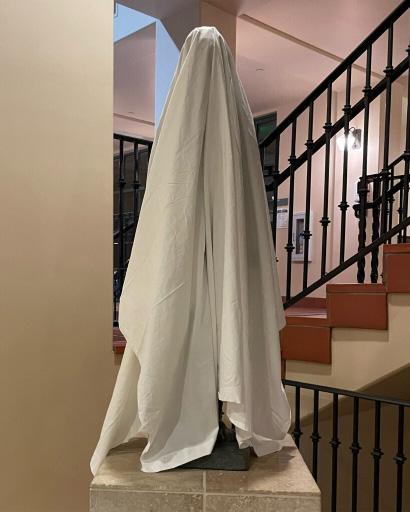
For Delman, this process needs to be carefully considered to ensure that the reasons for the decision do not replicate situations reminiscent of historical mass bannings. “On one hand you don’t want to follow that same model, but with different ideas, and yet it’s still something to talk about,” he said. “You don’t want to just pull things.”
Lehavi was disappointed about the stance the school took, though not surprised. “I would have been more surprised if they did mention Jews,” they said. Dunkin hoped the lecture would lead the community to “finally take steps towards accountability for the harm that Nazi art has caused for Jewish students at Scripps.”
By Anne Friedman ’25 Staff Writer
On April 4, Scripps College’s Ruth Chandler Williamson Gallery staff removed the Georg Kolbe sculpture, titled “Young Woman,” from the Tiernan Field House and placed it into storage. In addition to the statue’s removal, the college is currently in the process of forming a committee to write a policy that describes when and what is appropriate to remove from campus and the gallery’s collection.
Lily Dunkin ’24 first called for the sculpture’s removal Feb. 10, 2022 in an article published through The Student Life. She highlighted the problematic history of the artist and the problematic optics of the sculpture.
Through the article, Dunkin connected with Professor Jasmine Baetz, Lincoln Visiting Professor in Ceramics, who was teaching a ceramics course called Building Historical Memory. After asking Dunkin to speak to her class, Baetz began collaborating on the call to remove the sculpture.
“I began to really start to read the campus like a script or like a framework that was giving us subtle ways of knowing who is supposed to be there, understanding belonging, understanding our own sort of place and relation to these institutions,” Baetz explained. This interest in the role of art on campuses influenced her involvement with the project.
Prior to the statue’s placement in Tiernan, it was situated in the reflection pond in front of the Frankel and Routt residence halls. It was eventually chosen for installation in Tiernan because it is made out of zinc – a material that would be able to withstand both indoor and outdoor situations.
Kirk Delman, Interim Director of the Ruth Chandler Williamson Gallery, first heard about the controversy surrounding the statue when Dunkin’s article was released. While he ac-
knowledges that the path Dunkin took to raise awareness of the issue is not new, he also saw it as unnecessary. “It was a bit of a surprise because we hadn’t talked to Lily,” he said. “In hindsight, I had hoped that they would have come to the gallery providing the reasons the sculpture be removed and requesting for it to be removed.”
For Dunkin and other students, the sculpture does not represent who inhabits Scripps’ campus. Kolbe was on Hitler’s list of Divinely Gifted artists and created art for the Berlin Olympics as well as war memorials. The sculpture was made for the Berlin Olympics and represents an idealized petite, white Aryan woman. “What does it mean when we walk into a space and the only artwork in the entire space is an idealized white Aryan Nazi artist?” Dunkin asked.
For Ella Lehavi ’24, a Jewish art major, the sculpture carries an implication of what Scripps’ students should look like. “[The sculpture] sends a message about what expectations are,” Lehavi said “This is what a Scripps student should look like. It should be short, skinny, fit, but it should also be Aryan.”
The artist’s ties to the Third Reich and the body image ideal that the sculpture represents were emphasized in a letter sent to then-President Suzanne Keen and the administration.
The letter received 265 signatures from current students, alums, parents, faculty members, and staff members. Following President Keen’s resignation, communication was redirected to President Amy Marcus-Newhall who responded on March 23.
“The importance of this issue demands a rigorous, deliberative, and inclusive process,” President MarcusNewhall stated in her email. “Our initial review regarding Georg Kolbe indicates that there is conflicting historical evidence and before we take any action we need to do a thorough analysis. We are initiating this investigative process immediately.”
Lehavi sees this interest to cleanse Kolbe’s reputation as a way to ignore the harmful connotations of his art and context of the work’s creation. “Regardless of Kolbe’s stance or biography, the use of his art and the ideals that back up that usage add new context to it that bring it closer to that Nazi history,” they said. “It makes it art that keeps those ideas alive on our campus, and I feel like there was a negligence of that because there’s such a desire to justify Kolbe was this or Kolbe was that.”
Kolbe was also able to produce art at a time when Hitler made it impossible for non-Aryan artists to pursue a career. “One had to be a member of this Chamber [the Reich Chamber of Fine Arts] in order to be able to continue working as a visual artist at all,” Brauneis told his audience. This meant that Jewish artists could no longer buy materials and could not continue creating art.
Since it was created within this context, Brauneis sees Kolbe’s art as a representation of the Nazi system and its subjugation of Jews and other nonAryans. “He [Kolbe] didn’t give a shit,” Brauneis claimed. “He was a militant anti-Semitic person who wanted to be part of the Nationalist Socialist art system but wasn’t allowed to.”
Delman attended Brauneis’s lecture and the two connected the next day so that Brauneis could view the statue and continue a conversation surrounding what Delman described as “complications, decisions, about how works are interpreted.” The gallery does not have plans of selling or discarding the piece, but will keep it in storage so that students and other individuals can build onto the little research that has been done on the statue.
Brauneis’ lecture emphasized the need for having the sculpture removed due to Kolbe’s and the sculpture’s historical ties to the Third Reich, something that was only briefly mentioned in the email President MarcusNewhall sent prior to the lecture on
Looking ahead, Delman hopes that students continue involvement in this discussion. “What I haven’t heard is any solutions other than taking down the sculpture,” he said. “Are they interested in developing some sort of broad document that will assist us now and in the future in making these decisions?”
Both Dunkin and Lehavi hope that student art can fill the empty space in Tiernan where the sculpture once was. Delman agrees with this and showed interest in financially supporting a joint initiative with the art department to commission a student piece. “Involving students is what everyone talks about, so might as well do it,” he said.
TSV Editorial Staff 2022-2023
Aanji Sin ’24
Editor-in-Chief
Alyssa Wend ’24
Editor-in-Chief
Ellen Hu ’24
Editor-in-Chief
Isabel Suh ’24
Head Design Editor
Cecelia Blum ’24
Design Editor
Alyssa Leong ’23
Design Editor
Elita Kutateli ’26
Design Editor
Ellen Wang ’25
Copy Editor
Juliette Des Rosier ’26
Copy Editor Intern
Frances Walton ’26
Copy Editor Intern
Belen Yudess ’25
Social Media Manager
Julia Cox ’23
Webmaster
14 April 2023 • The Scripps Voice • Volume XXXI • Issue Seven 2 • News
Anne Friedman ‘25
• The Scripps Voice
Innovation at Keck: Dr. Sandra Watson, Dopamine, and Drosophila Fruit Flies
By Juliette Des Rosiers ’26
Copy Editor Intern
Dr. Sandra Watson is a new faculty member at the W.M. Keck Science Department, arriving this past fall as an Assistant Professor of Neuroscience. Her work explores the impact of neuron pathways on psychiatric and neurodegenerative disorders and is currently examining the behavioral implications of disruptions in dopamine metabolism.
Watson began her academic career at Spelman College, a historically Black women’s liberal arts college, where she received her Bachelor’s degree in Biochemistry. While at school, an organic chemistry course rerouted from her medical school into a passion for research. While pursuing her Ph.D. at Rockefeller University in New York City, Watson shifted her focus again, this time to biological sciences. She worked on a protein complex called the proteasome, observing its role in protein degradation that could be applied to neurodegenerative disorders. During this project, she learned the merits of the Drosophila fruit fly as a model organism.
“You can do so much in fruit flies from genetics to even behavioral studies,” said Watson. “So I fell in love with flies.”
Professor Watson continued on to Columbia University for her postdoctoral work where she expanded her research to include neuropsychiatric disorders and, interestingly, where their mechanisms potentially overlap with neurodegenerative disorders.
“Schizophrenia is a disorder characterized oftentimes by elevated levels of dopamine and so there’s a lot of disorders that can be comorbid with schizophrenia, including drug addiction,” Watson explained. Therefore, she was excited to look into how this dopamine process
could be linked to neurodegenerative disorders such as Parkinson’s, which is associated with decreased levels of dopamine.
“What we were doing with flies, which is pretty funny, is we were feeding the flies amphetamine,” Watson said. “These flies were fed amphetamine as a model, or a readout for mostly dopamine signaling, but also learning about how dopamine signals can teach us more about how schizophrenia works in humans.”
Now, Professor Watson has arrived at Keck to share her love for flies and dopamine with Claremont College students. Her research at Keck is focused on dopamine levels and, more specifically, dopamine metabolism, which Watson explains is often overlooked in research.
“We know that dopamine itself can form these toxic quinones that can damage neurons, but dopamine has other byproducts,” Watson explained. “So do those byproducts also cause toxicity? Or are they broken down to kind of protect the neuron?”
The implications of Watson’s work expand far past dopamine and Drosophila. The fruit flies share 60% conserved genes with humans, including the whole dopamine pathway. Therefore, Watson’s current work focuses on how genes could be linked to dopamine breakdown.
Each gene shown to regulate dopamine breakdown in flies is mirrored by the same gene in humans. Watson hopes that by fully characterizing these genes, her research could shed some light on how genetics impacts dopamineregulated neuropsychiatric disorders.
“We want to better understand that to get a better sense of why certain psychiatric disorders arise and what makes some individuals more susceptible,” she said.
As a faculty member, Watson greatly values mentoring students
while emphasizing student independence in her lab. She encourages students to find an aspect of the dopamine pathway that piques their interest, investigate background literature, and then works with them to formulate a hypothesis and procedure.
“Hearing these new fresh ideas is very exciting for me,” she said. “So I like that aspect. A lot. Just getting hands on with the students in the lab and teaching them how to do the techniques and then seeing how they can develop their own independent styles is really rewarding for me.”
An upcoming opportunity to work under the mentorship of Professor Watson is a lab project with the goal of identifying the missing link in the metabolism of dopamine in glial cells. A student would screen for a transporter that helps glial cells take up and then break down dopamine.
“I think that would be a really important finding because if we know what the target is, we can manipulate that target to either increase or decrease its function and have another avenue to regulate dopamine levels in the synapse,” explained Watson. This could lead to more methods to regulate behaviors that have dysregulated dopamine levels, such as schizophrenia, ADHD, and Parkinson’s disorder. This position will be available in the fall and Professor Watson encourages anyone who is interested to contact her.
Watson is passionate about helping students further their careers in science, sharing that it was a primary motivator for her becoming a professor. “I’ve always wanted to pursue a career as a liberal arts faculty member because of how it ties both teaching and research together,” she noted.
In addition to this, she enjoys supporting students in their postgraduation plans, whether that be a
graduate program, medical school, research, or another job in science. “I feel like it’s important to instill those ideals in students of how they can use these lab skills in pursuing their next steps,” she said.
Watson emphasized her devotion to mentoring Keck students of color, especially women of color. “Outside of being at a Black women’s college, I’ve never had a mentor who was a woman in science at my research universities,” Watson explained. “I think that one of the shocks for me coming from undergrad was that I went to a very top graduate university but there were very, very few women in STEM and zero Black faculty out of 100-something faculty.”
She stressed the importance of supporting women of color in faculty positions and their research. She expressed a need to analyze why faculty of color are so underrepresented, even more so than science students of color. Where is the disconnect that is preventing them, and especially women of color from pursuing a career in academia and education?
“I think it’s important to promote and give that support to new and young faculty coming in who are women, who are Black women, who are women of color, because I think it starts at those levels where students can see representations of themselves in these faculty and then pursue those types of careers,” Watson said.
Since she now acts as this representation for young Black women in science, she wants to prioritize mentoring students of color at Keck in any area of science, not just neuroscience. “I feel like Black scientists at Claremont are already underrepresented, so giving them that support and mentorship is something that’s really important to me,” she said
Scripps Re-evaluates its Living Learning Communities in the Midst of Housing Stress
By AJ Jolish ’25 Staff Writer
For the 2023-24 school year, Residential Life will be reducing the number of Living Learning Communities (LLCs) for the first time since their introduction in the fall of 2015. In the 2022-23 academic year, ResLife offered the Language halls (Spanish, French, German, Italian), the Science & Technology hall, the Green (environmental sustainability) hall, and the Wellness hall. Next year, this list shrinks to just the Language halls and the Wellness hall.
Carmen Brown, Interim Assistant Dean and Director of Campus Life, explained that the LLCs absent in the 2023-24 academic year are not permanently canceled. “We are pausing a few of the LLCs to allow for a full review of offerings,” she explained. “Wellness is the only community that has an increased interest and the highest participation.”
Participation in hall events is at the core of the LLC program, and the implication that the halls being reconsidered next year had lacked
robust enthusiasm was surprising to some students who had been interested in living in them next year. Anna Ravid ’25 had been planning to apply for the STEM hall.
“I liked the idea of living with people who study the same things I do,” Ravid said. “It would be fun to have that builtin connection with my neighbors, and maybe even be able to work together and help each other with our classes. I was sad to learn the hall isn’t going to be offered at all next year.”
According to Interim Assistant Dean Brown, “The primary goal of Scripps College Living Learning Communities is to increase student engagement outside of the classroom in ways that expand learning opportunities, strengthen community and bridge students’ curricular and co-curricular experiences.” Despite this, the LLCs have been finding themselves split between the “living” and the “community” aspects. With the very real fear of not being able to live on-campus, some students seek out LLCs that they’d tolerate instead of adore.
The tension between LLCs as providers of sought-after rooms instead of providers of community is rumored to be a reason for the program’s impending downsize. Nina Howe-Goldstein ’25 chose to apply to the Wellness hall due to worries of being placed off-campus.
“I was a sophomore with a bad housing registration time,” she said. “It boils down to the universal Scripps student desire to get on-campus housing, especially a single. It’s like with PERMS — when you’re emailing to get a PERM into a G.E., you bullshit.”
It’s hard to overemphasize the fear of being off-campus, especially after last year where many current sophomores were shocked by off-campus placements without their consent. Audrey Scott ’25, who was placed in Claremont Collegiate Apartments (CCA), said that “CCA may not be too far away, but it’s enough to lose the sense of culture and community that was one of the reasons I chose Scripps. I was disappointed that the school has not made more of an effort to acknowledge or address the
grievances and problems people here have, such as a difficulty getting to and from campus with only a shuttle that goes once an hour.”
Despite the desperation for oncampus housing, many students who chose LLCs were primarily motivated by lifestyle reasons. Athena Lewin ’25 lived in Revelle House for the 202122 year and is currently living in the Wellness hall.
“As much as I enjoyed the social aspect of [drinking and partying], I was like ‘you know what, that’s not going to be a big part of my college experience,’” Lewin said. “So I knew I didn’t mind being substance free, and the idea of living with people who were going to be focused on mindfulness and healthy living really appealed to me.”
The STEM, Green, and studentsuggested Queer/Trans hall, will all be evaluated next year. Until the 2024-25 school year, prospective applicants, no matter their contentions, will have to live without them.
Feature • 3 14 April 2023 • The Scripps Voice • Volume XXXI • Issue Seven
How Scripps Green Stays Environmentally Green
Juliette Des Rosiers ’26 Copy Editor Intern
After a flooded February and a snowy March, the “It may be d’rough’t but it’s necessary. Conserve.” signs seem almost comical. However, many Scripps students are aware that these climatic events are not reparations but actually implications of the climate crisis.
Every day, we must ask ourselves how we can improve our impact on environmental well-being, whether it be sailor showers or veganism. As a community and an institution, how does Scripps College critically assess its environmental practices and improve its carbon footprint?
The 2022 Sustainability Report presents a breakdown of the sustainability practices and initiatives of Scripps through the fiscal and academic year of 2021-22. This information was collated and the report was designed by Sustainability
Coordinator Lauren Ng with assistance from Scripps students Anna Huff ’25 and Sydney Hamel ’25.
The report uses 2019 as a reference date for comparing records of sustainability data since it provides the oldest, most accurate, prepandemic data. After the 2020 data set, energy use and emissions shifted due to elements such as increased air conditioning for ventilation or decreased travel from studying abroad. Therefore, until a “new norm” is established, 2019 is used as a baseline for carbon neutrality goals of which there is no goal date yet.
The report is comprised of 10 pages exploring the layers of sustainable operations and programs at Scripps College. Each page contains a summary, empirical graphs, and key recommendations on how to improve, starting with the Climate page.
The Climate page reports that, overall, Scripps’ carbon emissions have decreased since the baseline in 2019. This guides the report to the primary recommendation of setting an official carbon-neutral date by which Scripps will have offset its emissions to similar levels as 2019.
The Historic Emissions bar graph (pictured) introduces the value to scopes that define Scripps’ emissions data. Scope 1, 2, and 3 refer to
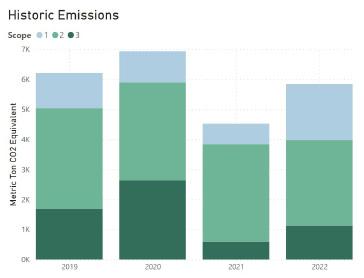
different sources of emissions, each broadening Scripps’ influence respectively. For instance, Scope 1 refers to the emissions of oncampus operations while Scope 2 observes outsourced elements such as purchased electricity, and Scope 3 tracks emission sources not owned by Scripps but still used by the college, such as travel or commuting.
These Scopes are evidently important to include, as the largest contributor towards emissions was purchased electricity. This does not belong to the immediate Scope 1, but Scope 2. Surprisingly, however, Scripps could still halve its carbon emissions if it switches to completely renewable electricity, as evidenced by the Energy section on page 3.
Scripps College has increased its energy usage across almost all fronts since 2019, reiterating the importance of incorporating sustainability into administrative planning on campus operations. The 30% increase in gas usage is concerning and, although not completely studied, likely attributed to a demand for heating. Therefore, if the college switched to electric or mixed sources, the environmentally detrimental energy use could be offset and carbon emissions due to natural gas would decrease.
In light of the infamous California drought and student concern over water use on the Scripps Campus, it is disappointing the limited data available to the Sustainability Committee on water usage. The report states 44 million gallons of water were used on campus, similar to the 41 million gallons used in 2019.
The committee is looking to find the right balance between upholding the administration’s desired aesthetic for a green-lawned Scripps campus while still nurturing responsible water practices. An important goal is the incorporation of submetering, or, the division of areas when measuring water use.
Recent drought restrictions as well as student input via SAS committees have influenced changes in water use. There is motivation to increase funding for water conservation program planning, such as the recently implemented drip irrigation.
The Sustainability Report also covers data on solid waste patterns. The data is based on the city of
Claremont, which reports recyclables based on estimated average pick-up weights and solid and green trash by mass. The report scrutinizes the 64% increase in landfill waste compared to 2019 and hypothesizes that this trend is likely due to the mandatory disposables use when the pandemic began.
The Sustainability Report highlights the ecological diversity of flora on campus that improves the college’s environmental footprint. For instance, through the use of native, droughtfriendly, and pollinator-friendly plants. In addition to the in-theground benefits, all the landscaping equipment is electric and the report mentions the introduction of new energy-collecting devices to improve environmental monitoring and, eventually, reporting.
The report is limited due to its exclusion of the W.M. Keck Science Center. Although Keck is considered a collaboration between CMC, Pitzer, and Scripps, dividing the energy, water, and waste habits of the center between the three schools is a challenge.
Additionally, Keck records these categories separately from the schools, making it difficult to streamline and process the data
alongside Scripps’ methodology. Therefore, it will be interesting not only to observe how the addition of the Nucleus in 2024 will affect the sustainability practices of Scripps but also how they will choose to record it.
The report also includes summaries of sustainability-related initiatives at Scripps College. It delves into the on-campus internships, research, and capstones that students participate in.
Lastly, the report spotlights the community-based on-campus sustainability initiatives. These included the CLORG Scripps Farm and yearly Scripps Scrapps. There is also a spotlight on the beloved olive harvesting tradition and the collegesponsored Sustainability Fair, the latter of which is returning on April 21.
The Scripps Sustainability Committee is enthusiastic about student involvement in sustainability initiatives, whether that be employment with Scripps Scrapps, joining a SAS committee, reporting ways to improve water conservation to facilities, or just attending a sustainability event. The Scripps Sustainability Report will shortly be available to students by email, so keep your eyes open for it!
Motley Introduces Monthly Student Art Markets
AJ Jolish '25
Staff Writer
Up until this semester, student art was available in the display case and on the counter by the door, and students were free to look through the offerings and Venmo artists directly for their work. Instead, the Motley now welcomes artists to set up booths for an art market in Seal Court once a month.
Avalon Brice ’24, the networking manager at the Motley, explained that theft was a large factor in the change. “It broke my heart to see student artist’s stuff being taken and them not being compensated for it, and it got to a point where the Motley was compensating for large amounts of people's art,” she said. “I don't have the capacity to constantly be monitoring what comes in and out, especially when it comes to student art. So I thought a monthly student art market would be like an easier way for that to function while still having student art being a large part of the Motley’s mission,” she continued.
Space in the Motley was also a concern, especially as COVID protocols were lifted, allowing the display case to return to its original use storing pastries. “At first we just accepted everyone who wanted to
sell with us, and the only reason that I stopped accepting people was that we just didn't have any space left,” explained Brice. “At one point last semester there were almost 40 people selling, and there's not very much space over our little corner to have 40 people’s art.”
Some artists were disappointed to see the old setup go. Corinne Stevens ’24, who sells clay trays and earrings, was one of the first student arts to sell her work in the Motley. “When people could look at my work and come back day after day and see the same thing, and keep their eye on stuff, and really think about it, I felt like I made a lot of sales. I kept selling out of my stuff and it was really gratifying.”
Stevens participated in the Motley’s first market during their reopening. “It did not go well for me, I think just because some of my stuff is really detailed, and larger and more detailed trays are more expensive, so when you have that and somebody is just walking by and looking at it and thinking ‘ooh, that’s too expensive for me to buy right now,’ they’re not getting that exposure of ‘maybe I’ll save up for it’ or ‘maybe I’ll ask my mom to buy it for me for my birthday,’” Stevens said. “Or even if it’s just not the right people, like the people who would want to buy my stuff aren’t
available to go to the market that night, then I’m not going to be able to sell anything.”
Eileen Kang ’26 had a more positive experience selling at the Motley’s opening market. “It’s a lot more engaging, and I like to see who’s buying my work, who’s interested, and being able to tell them more and give them the stories behind it,” she said. “Pieces of jewelry are very personal and very stylistic, and there’s more to it than just what it looks like. That aspect is really important and you don’t get that when you’re just dropping things off at a counter.”
The Motley held its second art market on April 6. As opposed to the opening, which had booths all around the koi pond and live music, this market filled only half of Seal Court and had music playing from a speaker. It also took advantage of the spring’s early evening sunlight.
The relaxed atmosphere of the market allowed students to circle the booths multiple times, stopping to chat with vendors and friends along the way. Each artist made the space their own; one vendor had two posters and a large laser cut piece for sale, while another covered two tables with expertly crafted crochet. The market ran from 5 p.m. to 8 p.m., and fielded a steady stream of attendees from
all the 5Cs.
One of the vendors for whom this market was their first time selling with the Motley was Cassandra Aléman ’21, who makes handcrafted body butter. “Today has been really good. We’ve had a lot of interest: a lot of people joining the mailing list and a lot of people purchasing,” she said. “It’s so inspiring to be around other handmade craftspeople. You don’t get that many opportunities to do this sort of thing in real life.”
The fair also hosted many returning artists. Stevens, who had qualms after the opening fair, had a better experience at the latest one. “This definitely went a lot better. Having it be light out, warm, sunny, and during dinner time- and not having live music- helped if people were feeling like it was too much of a party,” she shared. “I sold a larger piece I’ve been wanting to sell for a while. I also reduced my prices a bit and started selling some smaller stuff for people to buy as they’re walking by. I still wish people got to see stuff more than once a month, but I don’t think it’s the market that’s the problem.”
Keep an eye out for future markets to buy impressive hand-crafted goods and support hardworking student artists.
4 • News
Image Courtesy of Scripps College
14 April 2023 • The Scripps Voice • Volume XXXI • Issue Seven
And All Will Know the Wonders of Spotlight’s “Spring Awakening”
By Belen Yudess ‘25 Social Media Manager
There was nothing left to do but “just watch” and be amazed by Spotlight’s superb rendition of Spring Awakening, directed by Rosie Carr PO ’23. Between the cast’s outstanding performances and the crew’s genius execution, the show had several nights of a packed house during its run from April 23-26. From the palpable chemistry between the show’s leads Isha Singh ’23 (Wendla) and Nick Russel PO ’26 (Melchior), the eccentric and heartbreakingly vulnerable numbers by Benji Willet PZ ’23 (Moritz), and the delicate yet powerful voice of Abbie Addell ’26 (Ilse), the amount of talent within this cast was “just too unreal.”
Another aspect of this production that was brilliant was the addition of an ASL interpreter, completed by Isabelle Conti ’25, during the Sunday matinee show.
Spring Awakening, which is set in the 1890s, tells the story of a group of teenagers in Germany as they try to learn about sex and other taboo topics that the adults refuse to teach or talk to them about. The main arc surrounds the naive Wendla Bergmen and her growing relationship with the savvy and rebellious Melichior Gabor, however it also includes additional plot lines focused around sensitive issues such as suicide, abortion, and child and domestic violence. Additionally, the musical is centered around queer love, pleasure, and first experiences
The difficulty surrounding many of the show’s themes was not lost on the cast, and they attribute the handling of these elements as a large part of the musical’s success.
“I think it went really well because this show is very topic heavy and if not done with care, it can be received in a really harmful way,”
Singh said. “I think there was a lot of intention behind what we put on and the support we had for one another. I think the audience was so receptive to something that is quite a controversial musical and there was just so much love put into the show, and it felt very powerful and special to all of us.”
Lucia Stein ’23, who seamlessly played the roles of every adult woman, echoed this sentiment and expressed gratitude for the cast and crew for creating a safe space to put on the show.
“I think the product was amazing, but I think that maybe part of that, but also just more meaningful to me was that the cast and crew are so lovely,” she said. “It’s just a really delightful little family that we created. And I think that partially because of the heavy type of show that it is, and partially just because of the type of people who were in it, everyone is just a really kind and beautiful person.”
When it came to building this bond, Mia Venezuela ’23 whose soothing voice was heard as Ana, identifies long rehearsal nights as a major part of fostering the dynamics between the cast and crew. “I feel like you have to build that foundation, and that’s what really lets us connect and have that familiarity with each other which translates to our comfort on stage,” she said.
These relationships were extremely important for actors who had to participate in intimate scenes, either with another character or themselves. Apart from the support within the cast and crew, many of the actors participated in intimacy training to ensure their safety and well-being when acting in these scenes.
Michael Lu PZ ’24, who hilariously depicted Hanschen, saw these training sessions as an essential aspect of the acting experience.
“Even though it’s simulated sex or masturbation it’s still very intense and your body doesn’t always know the difference,” Lu said. “It’s important to be able to work with what your body knows or how your body knows itself in this situation.”
The cast also learned to lean on each other when it came to handling the more emotionally heavy scenes.
“Coming off from hard scenes like ‘Left Behind,’ we just banded together backstage and then relied on one another to get excited for the next scene,” Venezuela said. “We have our little references to different lines in the show and I think that’s how we can balance the emotional gravity of it and our real lives.”
In terms of learning the music for the show, which consisted of heartfelt ballads such as “Whispering” and upbeat showstoppers like “Totally Fucked,” music director Sam Clark ’24 did an excellent job in ensuring that each actor’s unique voice was highlighted and heard.
Clark beamed over the cast’s execution of the music and their dedication to each performance.
“I really appreciated how much I could tell people were working on things and how much care people put into the music,” Clark said. “There was a specific moment in ‘Purple Summer’ that, when thinking about it, I get goosebumps. We worked so hard on it and everyone was able to come together and we nailed it every single time. It’s one of my favorite memories from the show. I’ve never been a prouder mama in my entire life.”
The support system that the cast facilitated on stage was also prevalent behind the scenes, and Clark notes that the team’s encouragement gave her the confidence to direct.
“I was terrified, but everyone made me feel so comfortable and my goal was to make it so that everyone felt
comfortable at vocal rehearsals and at any rehearsal in general,” she said. “I wanted to be a support for people and I didn’t realize how much I needed the same thing from them and how much they gave it to me. I really appreciate all of them as humans and they’re all insanely talented. When people would say the music from the show is so good, I’d be like, I got the IKEA box of a cast. This is how you put things together, but they were so good and like I could listen to them sing forever.”
Although set in the 1890’s, the main themes of Spring Awakening are still relevant today: the silencing of the voices of youth, the banning of information, and the stigma surrounding mental, emotional and physical health crises.
“There are so many instances in which parents don’t talk to their kids or kids are not listened to and valued,” Singh said. “I think that it’s important that the show addresses how important it is to have resources concerning safe abortions or proper sexual education and also mental health in general. The storyline is about making sure that you’re paying attention to your children and not putting unrealistic expectations on them, and it’s done in a very beautiful way.”
Ultimately, Spring Awakening “bore” an impeccable result while calling attention to greater issues surrounding youth in today’s world. Although this musical is over, the cast encourages anyone interested in theatre to get involved with studentrun productions!
“You learn a level of self-assurance and self-confidence, but with a mix of chaotic unhingedness which meshes so beautifully together,” Stein said. “You have to put yourself out there and it’s a really good balance of having this assurance and also the ability to laugh and let go.”
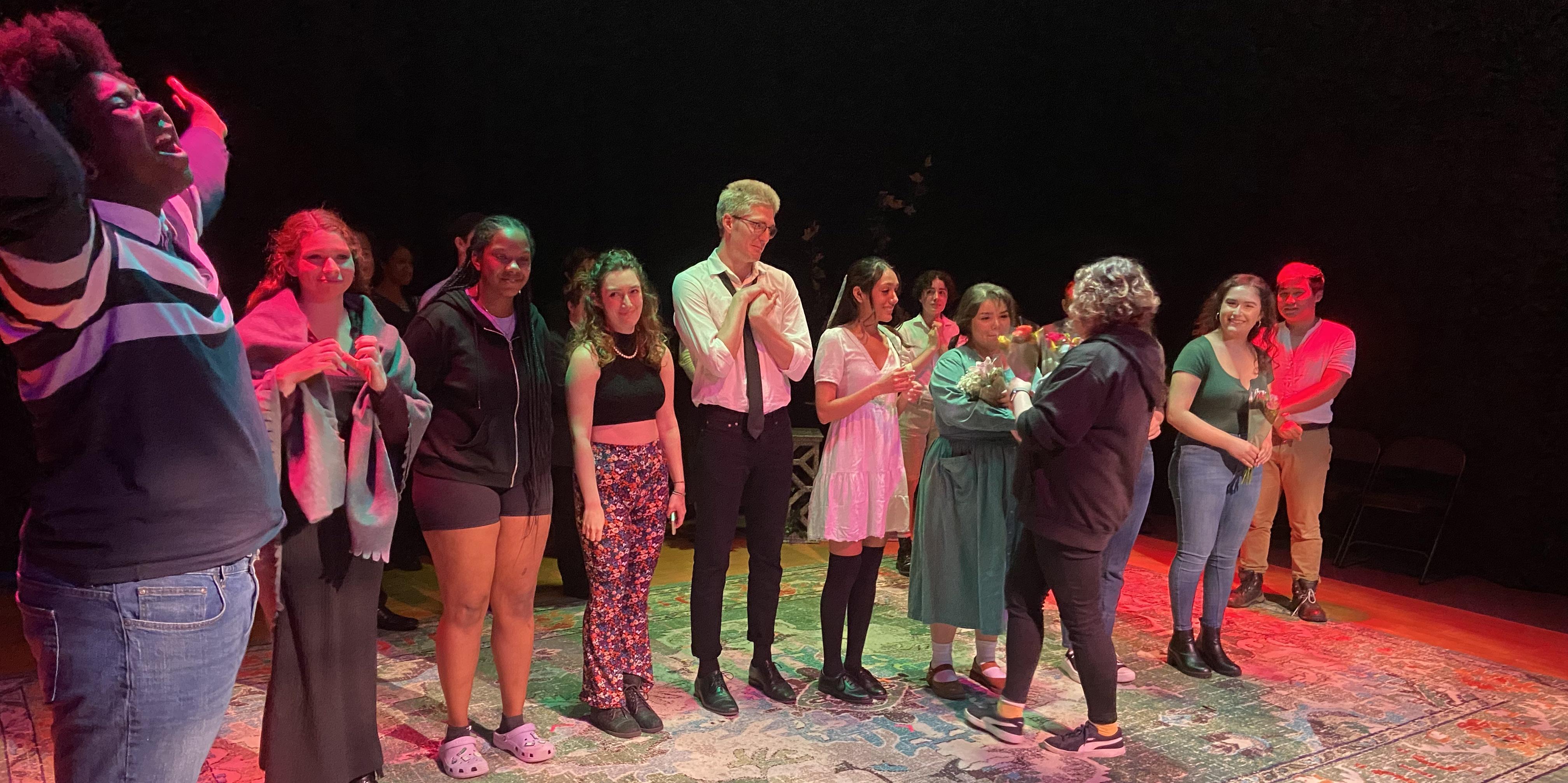
Feature • 5 14 April 2023 • The Scripps Voice • Volume XXXI • Issue Seven
Belen Yudess ‘25 • The Scripps Voice
A Snapshot of the Newest Club on Campus: The 5C Photography Club
By Ainsley Harris ’26 Staff Writer
OnApril 5, as Seal Court was bursting with activity during Wednesday Tea, I sat down to talk with Carolyn Coyne PO ’25 and Marvin Heilbronn PO ’25, the founders and copresidents of the 5C’s newest club: The 5C Photography Club.
The 5C Photography Club is the third iteration of a photography club at the 5Cs. Photography clubs are infamous for their impermanence at The Claremont Colleges.
“I talked to some people, upperclassmen, and they were like ‘yeah, photo club has just always died out,’” Coyne told me. With the history of previous photography clubs in mind and a desire for a photography community, Heilbronn and Coyne founded a photography club intended to last that is centered around community, inclusivity, and accessibility.
Even before coming to The Claremont Colleges, photography was an important part of both Heilbronn and Coyne’s academic and extracurricular lives. They wanted to continue to pursue photography at the 5Cs; however, they found an unfortunate lack of photography presence on campus.
“Honestly, I was surprised that the 5Cs didn’t have a photography club to begin with,” said Heilbronn. “We have a lot of niche clubs that are so unique to a specific passion, and I just think that photography as a whole should definitely have a space.”
The lack of a photography club was not the only disappointment they encountered when trying to find a photography community. Getting into photography classes as the 5Cs was
harder than they expected.
“So many people try to PERM in and it never happens,” said Coyne. “I think there is not enough photo classes and not enough art faculty to support the community of artists that are here.”

While Coyne and Heilbronn are both enrolled in photography classes this semester, they created The 5C Photography Club as a response to the challenge of getting into photography classes and to the lack of an extracurricular photography presence on campus.
“The goal of the club is to just have people who feel this passion, whether they are advanced and have been doing it for years or if they are just starting.”
-Marvin Heilbronn PO ’25, founder and co-president of The 5C Photography Club
“It [starting the club] was really just about creating a community,” said Heilbronn. “I wanted to share that opportunity with other 5C students.”
While there was undoubtedly a need for a photography club on campus, establishing the club was not without its challenges. While the club was a passion project for the two co-presidents, it also required months of logistical work. “I did have a couple meetings: One to meet in general just about starting and just propose the club and have it approved, one for securing a room which was actually more difficult than I thought, and another to talk about funding,” Heilbronn shared.
Further, since the club was founded this semester, months after the club fair last fall, recruiting members and spreading the word presented its own
unique challenges.
“One thing that we used was social media,” said Coyne. “We both used Instagram, and would post on our Instagrams. We created a 5C photography Instagram, using that to promote, and just simple world of mouth. I would just go around talking about it to people. Having really tangible interactions with people matters a lot… it really helps you start something from the bottom up.”
As labor intensive as forming the club and recruiting was, their work paid-off as the photography club now hosts regular meetings and has a steady, growing membership. Coyne and Heilbronn stressed in their promotions that anyone is invited to join.
The 5C Photography Club is centered around inclusivity and accessibility. They welcome anyone of any skill level, any amount of experience, using any camera — including their iPhone camera. “The goal of the club is to just have people who feel this passion, whether they are advanced and have been doing it for years or if they are just starting,” said Heilbronn.
Moreover, as the club grows and receives more funding, the co-presidents are working to provide solutions to any financial or technological barriers that prevent anyone from participating in photography.

“One thing is going to be funding a camera library,” said Heilbronn. “Right now we are aiming for two digital cameras and two film cameras and some of that funding towards buying and developing film.”
While several members use their iPhones to take pictures, access to digital and film cameras will help members learn new types of photography and new skills without any financial expense or needing to be enrolled in a course.
Even without funding from the school, Heilbronn and Coyne laid a strong foundation for the club and provided meaningful, educational experiences at club meetings and field trips. Heilbronn and Coyne lead lessons or demos at club meetings. They introduce photographers and discuss how to emulate their techniques. They also teach software skills such as Photoshop; teach members how to use the software and speak candidly about their own experience with the platform.
“Adobe is great,” said Coyne. “They have dozens of videos, but I think, at least from when we’ve worked with our club members, I think it’s helpful to have us physically there being really honest about the trouble I’ve had with Adobe, and how long it took me to learn. I still struggle with Photoshop a lot.”
“Honestly, I was surprised that the 5Cs didn’t have a photography club to begin with. We have a lot of niche clubs that are so unique to a specific passion, and I just think that photography as a whole should definitely have a space.”
-Marvin Heilbronn PO ’25, founder and co-president of The 5C Photography Club
The club also goes on group field trips where they receive hands-on, immediate instruction and feedback. In the future, they’d like to go to the Santa Monica Pier, Los Angeles, Mt. Baldy, and anywhere else members want to shoot. Heilbronn sees these as great opportunities for members to gain experience “looking through the camera, taking the photo, and then being able to, in that moment, get feedback and say, ‘How can I adjust my settings? How can I frame that better?’ and then continue on.”
Coyne’s favorite part of the club are the monthly projects. The club workshops a theme together, shoots individually or in groups, and then they all come together and present their work to the club.
“The first one was a candid photography project. We tried to create a balance of having a project that was specific on one theme, but was very open ended,” said Heilbronn. “We wanted to have the room for people to create what they wanted, but also see what people created with such an open ended theme.”
Beyond just showcasing their work at meetings, the club also features student photography as ‘artist features’ on their Instagram: 5cphotoclub. The club is also planning an end of semester gallery.
If you’e interested in The 5C Photography Club or want to view spectacular photography then check out their gallery! The event will be held at Scripps — date and location is still pending — so keep your eyes on the 5cphotoclub Instagram for updates.
6 FEATURE 14 April 2023 • The Scripps Voice
Kimseng Suon • Pomona ‘26
Carolyn Coyne • Pomona ‘25
A New Year, A New SAS Team
By Belen Yudess ’25 Social Media Manager
The race for SAS is over and the 2023-24 board has been elected! The results were announced via email on April 7, introducing current Junior Class Co-President Lily Dunkin ’24 as SAS President and current CoTreasurer Blessing Roland-Magaji ’24 as SAS Executive Vice President (EVP).
Among the other newly elected members to the executive board are Melina Durre ’25 as Vice President of Student Affairs (VPSA), Isabella Guizler Bonilla ’26 and Reyna Manriquez ’26 as Co-Treasurers, and Quinn Dwyer ’26 as Secretary.

Dunkin, a politics major with a minor in Foreign Languages (Spanish and French), has been an integral and uplifting part of SAS. Since her election for the 2022-23 academic year, she has helped organize and led several of this year’s successful events such as SAS field day and writing letters to students abroad.
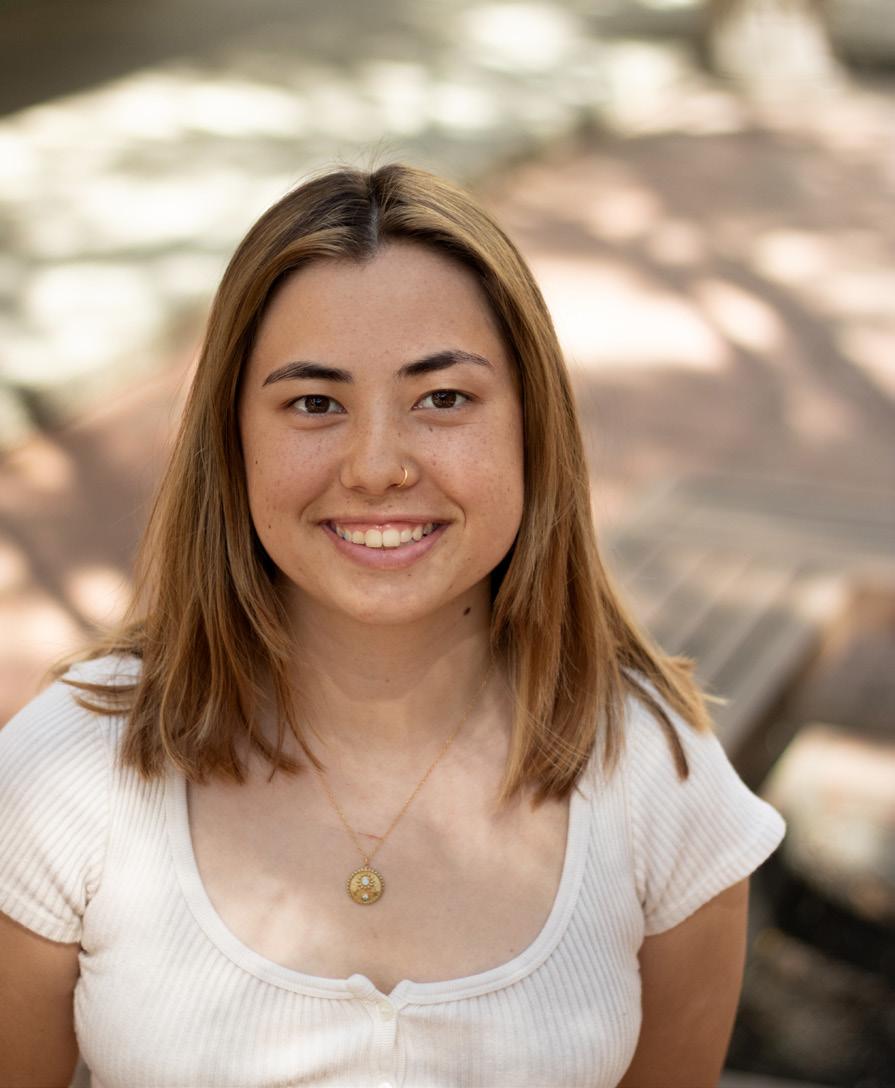
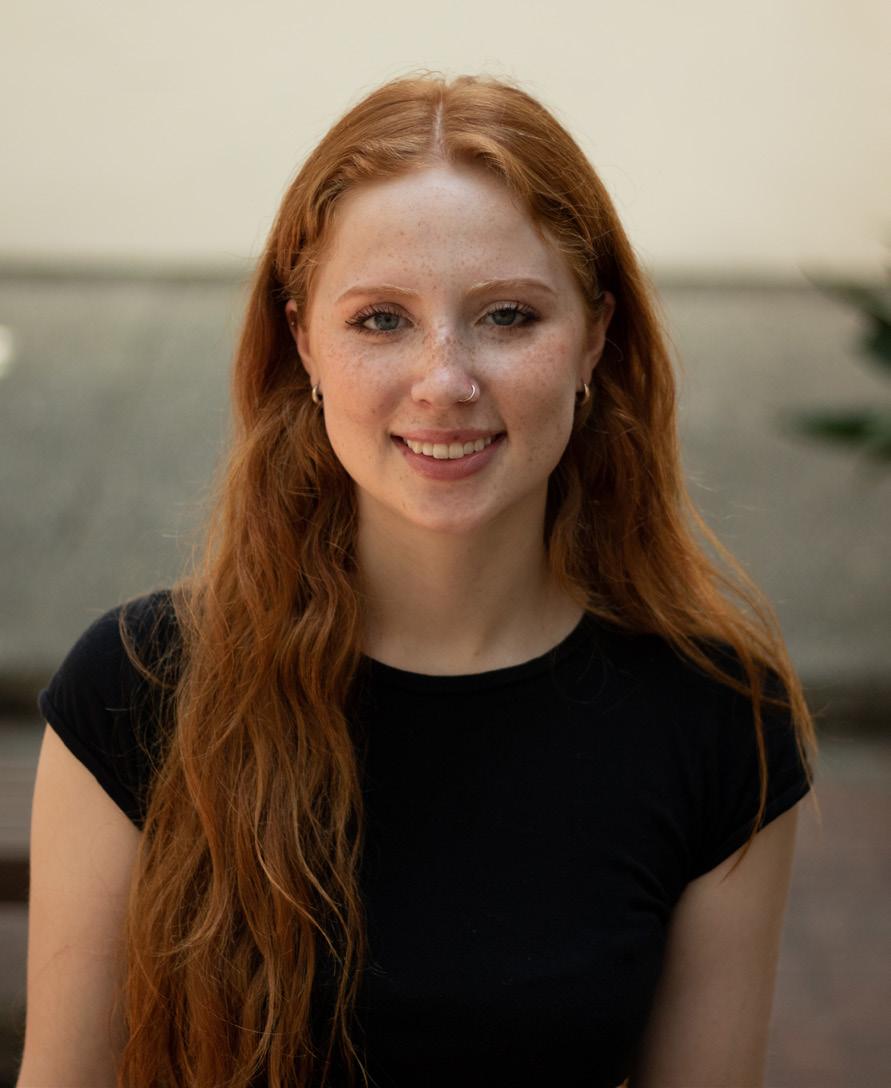

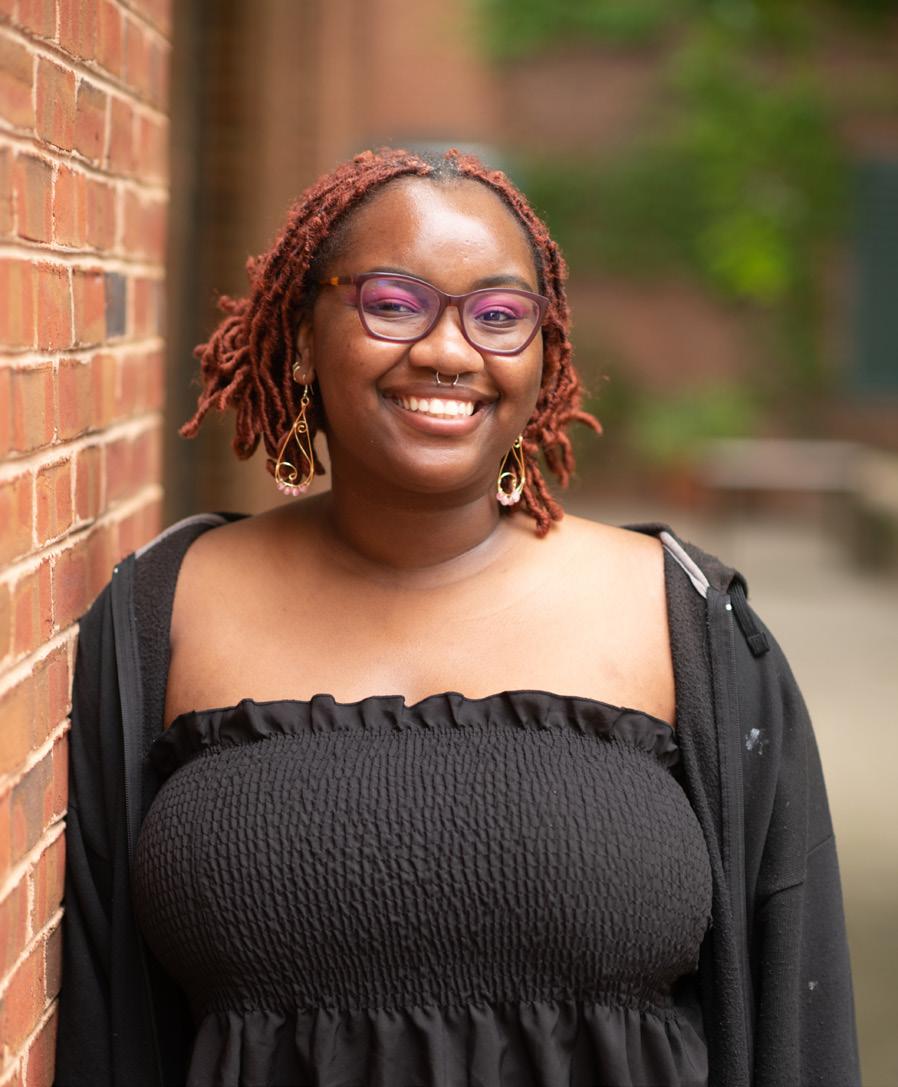
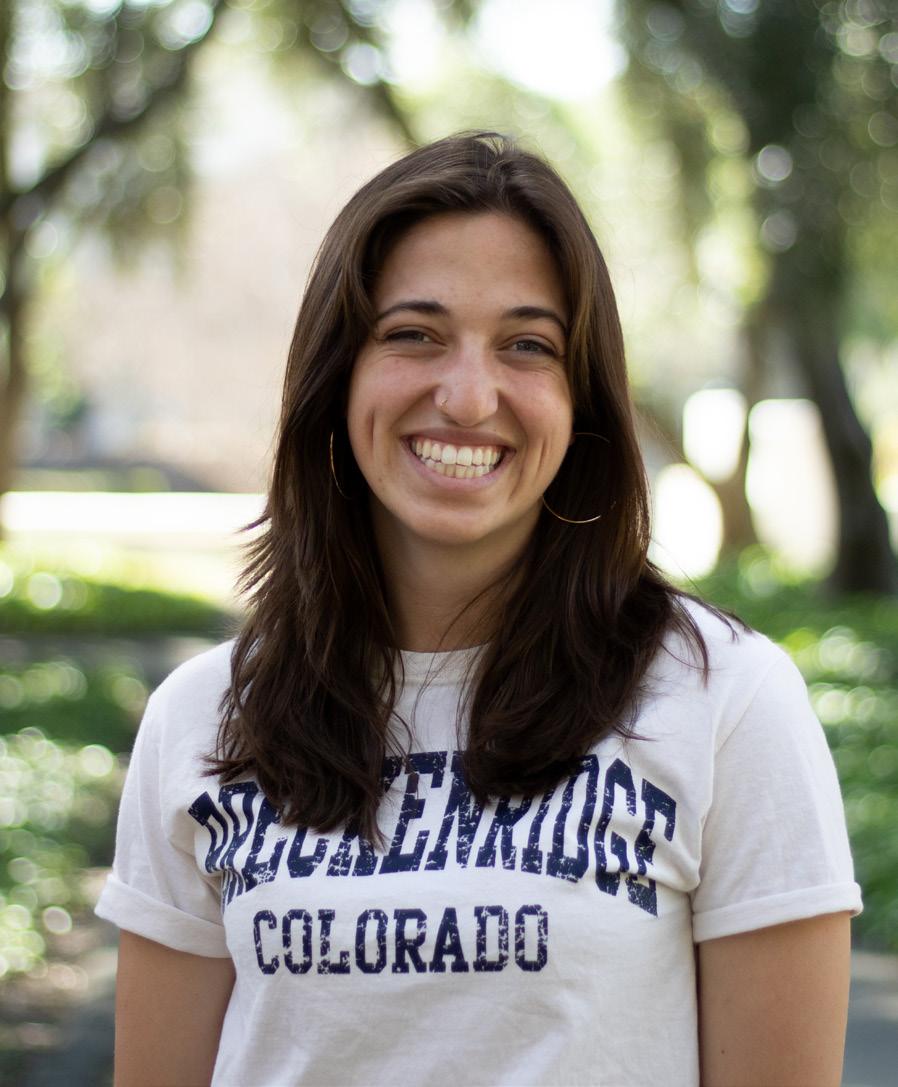
Apart from SAS, Dunkin has led several campus wide initiatives such as reproductive justice protests in spring 2022 and the removal of the “Young Woman” statue, whose artist has Nazi relations, from the Tiernan Field House. Dunkin cited her enthusiasm to empower the SAS team and student body as her primary reason for running.
“I think what’s amazing about the role of SAS president is that you
have the power to facilitate different ideas and movements, and that was really exciting for me — to be able to give people a platform to reach out,” Dunkin said. “I also wanted to run because I started to interact more with the administrative side during my second semester of being Junior Class President. I really see the value in being a student-faculty/ administrative liaison.”
Looking at her past experiences working with administration, Dunkin believes that the keys to building strong student and faculty relationships are transparency and identifying common goals.
“What I’m hoping to see more of is a collaborative mindset when approaching problems as admin and student representatives,” she said.
Although Dunkin has many ideas and beliefs concerning how she wants to proceed with her presidency, she has three core values that are the basis of her platform: community, action, and accountability.
“I want to hold people accountable and have them recognize the power that we have as students on campus, and recognize the power that our leaders have as leaders on campus,” she said. “By acting on that power and by providing a structure where people feel empowered to create community, I think there is a lot of potential for that at Scripps. That will include campus-wide Narcan training, town halls with admins so that everyone can participate in these
“I’m also hoping that SCORE is able to mobilize and that the communities that meet there are able to get their needs met,” she said. “We can talk the talk, but at the end of the day, we need to hold people accountable. We need to act when it’s time to act, and we need to hold people closer as a community.”
Dunkin also highlighted her appreciation for the SAS team and their ability to bring people together in order to learn and row with one another.
“I love SAS — I think that the people who are elected into these roles really care and it’s one of the most diverse groups on campus,” she said. “I don’t just mean by ethnicity or orientation, I mean actually diversity of majors and diversity of thought. Being able to have that group of people meet every single week, you really get the full gambit of student experiences. I’m hoping that in our meetings and going forward next year with events that we’re able to continue to create spaces where people can show up authentically for who they are and know that they’ll be listened to and valued as members of the larger Scripps community and within our little SAS family.”
Reflecting on her time in SAS, Dunkin is grateful for all the students who have participated and embraced the many SAS events this year, naming the Harry Potter Study Hall and Motley movie nights as some
of her favorite memories. She also noted that the student body’s ability to foster positive and welcoming environments has been what makes each event special.
“Any event where students feel like they can show up to the event alone and meet somebody or still have a good time, that’s the event that I remember the most,” Dunkin said.
In addition to the executive team, commissioner positions included Raka Mukherjee ’25 for Sustainability Chair, Simran Sethi ’26 for Diversity and Inclusivity Chair, Abbie Oh Arroyo ’25 for Faculty Staff Relations Chair, Kaitlyn Chen ’24 for Judicial and Academic Review Chair, Alex Hamilton and Sarah Paper as Co-5C Event Chairs, Rebecca Yao ’26 for Student Organizations Commissioner and Geeta Karlcut ’26 for Community Building Chair. This year’s class presidents will include Celine Aoki ’26, Kimai McPhee ’25 and Anabhra Singh ’25, and Destiny Rivera ’24 and Tara Zhang ’24.
Although Dunkin is looking forward to many different components of her presidency, she is most enthusiastic about interacting and building on the determination present within the Scripps community.
“I think being able to talk to people and having this network of incredible, formidable Scripps badasses is really powerful,” she said, “We’re able to lean on each other and I feel like I can lean on my community.”
7 FEATURE Voice • Volume XXXI • Issue Seven
Photos by Ellen Hu ’24 • Scripps College
Lily Dunkin President
Blessing Roland-Magaji Executive Vice President
Reyna Manriquez Co-Treasurer
Isabella Guizler Bonilla Co-Treasurer
Quinn Dwyer Secretary conversations.”
Melina Durre Vice President of Student Affairs
Is Ordinary Good Enough? Appreciating the Little Moments While Studying Abroad

As an introvert, I could feel myself already becoming overwhelmed by the amount of effort I was investing in putting myself out there, trying to make connections with people, and doing as much as I could with my time. By the end of the first week, I wasn’t sure how I was going to keep this up the entire semester.
When I couldn’t find a way to stop moving, life made the decision for me two weeks into my arrival. After testing positive for COVID-19, the sudden transition from my hectic first week to isolation was a stark change.
Part of me was glad to rest and recharge, but another part of me couldn’t stop thinking about the time I was losing and how I could make up for it later. Even when doing nothing, I felt the self-imposed pressure to keep searching for what would make this time my “life-changing experience.”
These weren’t bad weeks, but I wasn’t allowing myself to feel satisfied with what I was doing. It somehow didn’t feel good enough. Instead, I only shared what the next extraordinary thing I was planning on doing.
After these weeks, my next exciting experience finally came – traveling with my friends to Switzerland for our spring break. We planned to traverse the country in one week with activities scheduled for each day. This surely was going to be a trip worthy of telling my family when I got back, and it was – just not for the reason I initially thought.
By Alyssa Wend ’24 Editor-in-Chief
In the weeks leading up to my departure to London for my semester abroad, I kept hearing variations of the phrase, “this is going to be a life changing experience,” from my friends and family. While I was grateful for their enthusiasm, I began to dread this phrase and had no idea what “life changing” was supposed to look like for me. I could already feel the pressure building to come back affirming their statements.
From general accounts of people who have studied abroad, I knew that the unique experience is one that can shape people. I watched
Tomato Sauce
By Rebecca Allen ’25 Staff Writer
Every night
I have a different nightmare. In the morning, Doves call and Lawnmowers hum. I’m alone again And it feels Like going backwards.
In the afternoon, I walk fast and Listen to my music, A riot grrrl, Staring down everyone, On a mission
To race the sun.
a close friend come back from her study abroad experience with a new confidence that made her noticeably different. I admired this, but I wasn’t sure how she got there.
When I was finally leaving for London, I felt a mix of fear and optimism. I am not usually the biggest fan of change, but all I could think about was how lucky I was to have this experience and I wondered how I was going to make the most of it.
During my first week in London, I committed to making the most out of each day: I packed my schedule with exploring the city with new friends. While this was an amazing experience, it was also incredibly draining.
I began thinking in shareable moments, judging the worthiness of an experience based on whether it was worthy of a story to my parents to prove that studying abroad was worth it. This mindset had me unknowingly categorizing moments as either “ordinary” or “extraordinary.” I found myself discounting the weeks where I felt like I was doing nothing but classes even while all of my experiences were not “ordinary” by virtue of being in another country.
I didn’t realize that this mindset was hindering my experience until I began just waiting for these extraordinary moments. A month into studying abroad, I felt like I was doing nothing. I had settled in my routine: going to class, doing homework, grocery shopping, doing laundry, and occasionally hanging out with friends.
In this week-long trip full of excitement, one of my favorite moments ended up being one of the most ordinary ones: sitting on a bench alone in a park just thinking. While I had great stories about the rest of my trip to tell my parents, I had a newfound appreciation for these more peaceful moments. I have loved exploring the city and being able to travel, but I have often found just as much or even more joy in what I previously considered ordinary moments. Experiences I know I will cherish and look back on include walking in the park next to campus or sitting with my friends in one of their dorm rooms. While these are things I could experience at home, I have learned to view these moments as just as life-changing as others.
As I reflect on my first two months abroad, I suddenly feel less afraid to share my experience with my friends and family at home. While there isn’t a single moment I can point to and say “that changed my life,” I can confidently say that I have found value in every experience, extraordinary or mundane.
Heartmend Spell (or, Sadlibs) This Is Just To Say
By AJ Jolish ’25 Staff Writer
1
Make sure it has been at least _____ (number of minutes) since the moment of the wreckage. Take a shallow breath. Heave a shallow sigh.
Feel _____ (emotion, productive) even though you will not want to.
Resist the urge to _____ (verb, unproductive) even though it will be so very tempting.
Remember _____ (memory, fond). Don’t remember _____ (memory, unfond).
Make a list. Make _____ (your favorite food). Make your bed.
Make up a different world where this never happened. Then unmake it.
2 Listen to _____ (your favorite song). Listen to _____ (advice, well-
meaning).
Try _____ (home remedy). Try _____ (sport you’ve never liked). Try _____ (religion). Try again. If you call _____ (past love), hang up after the _____ (ordinal number) ring. Don’t think about rings.
3
Start _____ (something you’ve always wanted to do).
Act like _____ (someone you’ve always wanted to be).
Remember _____ (a dream from your past).
Imagine _____ (a dream for your future).
Make sure to say the magic words:
By Nina Howe-Goldstein ’25 SAS Event Coordinator, Occasional Poet
I have strung up the plastic skeletons that were in the decoration kit for Apocalypse Party and which you were probably hoping I would hang literally any other way Forgive me they were $5.99 each on postHalloween clearance sale so distastefully displayed from those weird naked trees outside Malott and so skeleton-y
14 April 2023 • The Scripps Voice • Volume XXXI • Issue Seven 8 • Column
Alyssa Wend ‘24 • The Scripps Voice
ACROSS DOWN
7. Danny, Jesse, and Joey raise D.J., Stephanie, and Michelle in San Francisco
10. The Bluth family is thrown into chaos when George Bluth Sr. is sent to prison
12. A bright-eyed school teacher moves in with four men
14. Dre, Rainbow, Zoey, Junior, Diane, Jack, and Deontre
15. Winner of this Heist is named the ‘ultimate detective slash genius’
19. 2023 Golden Globes Best Comedy winner starring a mostly Black cast
20. Classic 50s sitcom starring Lucille Ball
21. “Troy and Abed in the ____”
24. Creator, producer, writer and star of Abbott Elementary
27. Government change can happen in this sitcom starring Amy Poehler
28. 90s sitcom following a group of six people in their 20s in New York
29. Colombian American Actress who plays Gloria Delegato-Pritchet
1. Deputy Parks Director of Pawnee, IN
2. Mockumentary following the employees of a paper company in Scranton, PA
3. Tonight is going to be _________- wait for it- _____
4. An unlikely group comes together to study for their Spanish class at Greendale Community College
5. “Don’t ______ the B**** in Apartment 23”
6. Show following Eric Forman and friends
8. Show following a blended extended family
9. There is always money in the ____ stand
11. Police show set in New York poking fun at police dramas, _________ 99
13. Show following Ted Mosby and friends
16. Show following Zack Morris and friends in the 90s at Bayside High School
17. 30 ______, show starring Tina Fey and Alec Baldwin as they put on a live show every week
18. Show written and produced by Kenya Barish based on his own Black family
22. Paper company that Micheal Scott manages
23. Drinking game played in apartment 4D, game starts with the chant, 1, 2, 3,
4, JFK, FDR
25. Liz Lemon is the head writer and producer of
26. “So no one ever told you life was gonna be this _____”
27. Magnitude’s catchphrase

Crossword • 9
14 April 2023 • The Scripps Voice • Volume XXXI • Issue Seven
Crossword: Sitcoms
In Hell or High Water, Hozier Cannot Be Damned
By Juliette Des Rosiers ’26 Copy Editor Intern
If referencing religious motifs was Hozier’s signature, his upcoming album Unreal Unearth is the equivalent of spraypainting his name across the Vatican.
The entire album will follow Dante’s Inferno, with songs guiding the reader through the nine circles of hell. To give his loyal fans a taste of what is simmering, Hozier generously released an EP with three songs rather than just a single. In another religious allusion, Hozier released the EP on March 17, otherwise known as St. Patrick’s Day. A fervent critic of the Irish Catholic Church, the release date was not only on theme with the album’s motifs but acted as a sonic “fuck you” to the Church. The EP is reminiscent of Hozier’s characteristic sultry, earthy sound and preps fans for a promising album release come summer.
The first song “Eat Your Young” represents the third circle: gluttony. In the song, Hozier describes a feast being prepared amid devolving chaos. However, the singer strays from the traditional definition of gluttony revolving around an insatiable desire for food. He expands the metaphor, including gluttony for money, violence, and sex. The verses allude to sexual
acts, referencing teeth, heat, and dressings while the pre-chorus adds aspects of racing toward success and money. The song’s sound is dark, driving, and syrupy. Layers of percussion and guitar fade to swelling violins and piano that form a bewitching, seductive ambiance. In the chorus, Hozier references violence in the lines “Skinnin' the children for a war drum/Puttin' food on the table sellin' bombs and guns” commenting on how his voracious appetite for violence comes at the sacrifice of children. The tagline “It’s quicker and easier to eat your young” is the final nail in the coffin of a rather morbid song. Hoxier ruminates that, in the dog-eat-dog world he built, the most efficient means to satiate his gluttonous desires would be to eat the young.
When the music is in conversation with the lyrics, the song reminds us of imminent danger, but not one worth stopping for. It feels like reaching out to touch a candle flame, the tantalizing sway of the fire biting back any warning of the sting of a burn. The moments of warmth before it must be worth it, right?
portray this, Hozier preaches a Gen-Z favorite: “nothing really matters.” This counters the social expectations of tireless work and certain religious teachings about how your actions reflect on your life after death or rebirth. His line “All that we intend is scrawled in sand” turns the common phrase “etched in stone” on its head to emphasize how flimsy plans can be. However, Hozier relieves any potential pessimism by ending the chorus with the couplet “Won't change our plans/ When we begin again.” This sentiment is supported by the soft jazzy music that gently uplifts the song to promote perseverance in the knowledge that reality is fleeting.
At the end, Hozier pulls upon the religious aspect of heresy by adding a gospel choir to the final two choruses. The sonic irony of having the choir sing about the impermanence of one’s actions and desires drives Hozier’s message and brings the song to a moving close.
a verse telling of a man swimming into a deep sea. The song starts stripped of instrumentals but builds to an explosive chorus that speaks of finding strength that flows through him. Also characteristic of folk music, the song follows a basic A-B-C form through repetition of the verse, prechorus, and chorus melody.
Hozier once again employs a full gospel choir to add power to the driving instrumentals. “Through Me (The Flood)” exemplifies how Hozier can take themes of common, arguably exhausted conversation surrounding the pandemic and make it anew.
The third song strays from the theme of Dante’s Inferno but is no less interesting. In a video on Instagram, Hozier explains that “Through Me (The Flood)” was written at the beginning of the pandemic and reflects his search for strength and optimism in uncertain times. Hozier pulls on the storytelling techniques typical of his folk music and begins the song with
After three years with minimal music, Hozier surprised fans with a generous release that did not disappoint. Although it is unlikely that, based on the three teaser songs, Unreal Unearth will explore a new sound or new genre, it demonstrates promise for an interesting album. Hozier will likely once again demonstrate his mastery at writing an album that is both sonically cohesive and dynamic. Additionally, as exemplified in the EP, his elusive songwriting will aid in unraveling the complex themes of Dante’s Inferno. Hozier never fails to disappoint or surprise, with the Eat Your Young EP provoking intrigue and excitement for his long-awaited third album.
In Season Two, "Shadow and Bone" is Murkier than the Shadow Fold
By Alyssa Leong ’23 Design Editor
Badnews 2010s YA readers, good news everyone else: the second season of Shadow and Bone has been released on Netflix (and has been there for the last month, but who’s counting). Adapted from Leigh Bardugo’s Shadow and Bone trilogy and Six of Crows duology, the show follows characters throughout the Grishaverse: a fantasy world where some wield the power to control the elements. In season two, Sun Summoner Alina Starkov (Jessie Mei Li) continues an attempt to end the reign of The Darkling (Ben Barnes) while a gang called the Crows continue to aid her through their own exploits.
When Shadow and Bone season one premiered, despite my high expectations as an ex-Grishaverse fan, I was pleasantly surprised. Sure, the show was not *quite* an accurate on-screen portrayal of books I held close to my heart (mainly the Six of Crows ones, less so Shadow and Bone — a bias that will be evident here). Nonetheless, I could put my own personal vision of the books aside and enjoy the show for what it was: an entertaining Netflix adaptation of a fantasy YA series.
But in season two, the balancing act between the two plots collapses entirely — and neither storyline comes out on top. Alina’s journey is adapted from the Shadow and Bone series, while the Crows’ is from the Six of Crows duology. Both these books take place in the Grishaverse, but years apart. Trying to knit them together is a difficult task,
“All Things End” skips to the sixth circle to explore heresy. Heresy is defined as the rejection of social customs or, more commonly, expectations of organized religion. To especially in a season meant to bridge the two series’ plots.
Right off the bat, the season begins with narrative starts and stops and the pacing continues to splutter on unevenly throughout the rest of the season. Episodes attempt to focus on both Alina’s storyline and the Crows, not truly giving the right amount of screentime to either. In the books, Alina follows similar plots for the whole trilogy, attempting to search for amplifiers to her power in order to stop the Darkling — a plot that does not translate neatly to screen especially given the fact this season is trying to cover not one but two books in the Shadow and Bone trilogy. However, given that the show centers around Alina’s story, her conversations with dignitaries and middling romance with Mal (Archie Renaux) have the most screen time.

Meanwhile, the Crows are delegated to relatively meaningless side quests that are somehow given the screentime of a larger plot point, as if the audience has investment in characters they have only just met. This is especially disappointing given that the Crows’ books are more action-packed, focused on heists, and character driven. Episode six, for instance, spends its last act laboriously revealing a relationship between the people the Crows are attempting to con — something that neither book fans nor show fans care about, in the scope of the larger story.
Similarly, because of the new timelines, many of the emotional climaxes feel unearned. As a book fan, I was disappointed that so many moments
lacked the emotional weight they felt in the source material. These unearned emotional payoffs are exemplified in the fourth episode, which reveals Kaz Brekker’s feud with rival gang leader Pekka Rollins (Dean Lennox Kelly) through a series of flashbacks. Kaz also tricks Pekka into getting revenge, a moment that is the culmination of everything Kaz works towards in the book series. But at this point in the show, when we barely have any understanding of what Pekka Rollins means to Kaz, the moment feels insignificant. Two promising narratives have been completely collapsed to fit all of these conflicting storylines into one season of television.
Like many young adult Netflix originals, Shadow and Bone prioritizes ridiculous romances over any kind of narrative sense, yet somehow none of them stick. Despite many of Alina’s motives in the show being driven by her relationship with Mal, their characters have very little chemistry. Even fan favorite couples such as Jesper and Wylan, Kaz and Inej, Matthias and Nina, and David and
Genya fall short.
breathe
time
amongst the jumble of other plotlines. It’s one thing to be invested in the main romance and no others. But if the creators can’t even get sparks to fly for any of the couples, it is not a reflection of the actors, but a reflection of the writing and directing.
But in the end, as a book fan I have to acknowledge that the show will simply not fulfill everything I want it to achieve. At the end of the day, Shadow and Bone does its job of being a mildly entertaining teen fantasy drama, albeit a mediocre one. Sure, in my ideal world we would have an HBO adaptation of just the Six of Crows books with the right direction and talent attached. But in the here and now, Elon Musk runs Twitter, artists release sped-up versions of their songs as made trendy by TikTok, and we have Shadow and Bone. It’s a fine show, but it had so much potential to be great, and that will continue to irk me for as long as it runs.
Arts and Entertainment• 10
The chemistry between these characters, while given more
to
in the books, is condensed
14 April 2023 • The Scripps Voice • Volume XXXI • Issue Seven
Courtesy of Netflix
A Farewell Message from Former President Suzanne Keen
By Nina Howe-Goldstein ‘25 Cracked Two Ribs at the Function
Dear Scripps College Community Members,
I bet you thought you’d finally escaped Interim President Amy Marcus-Newhall, huh? You thought that just ‘cause we gave her a sad little patch of mulch on Jacqua and called it a ‘rose garden,’ you might be free from the tyrannical rule of a woman with a five-star RateMyProfessor score and a hyphenated last name? Tough luck! Suzie is outta here.
You might be wondering… why? Why would I leave less than a year in, a month before my official inauguration? Why would I dip after Scripps spent so much goddamn money sending me all over the country promoting the school? Why, when every single student at this miserable institution identifies as an empath, would they fumble the bag on one of the world’s leading scholars of empathy?
The answer is simple: no hairstylist in Claremont, Los Angeles County, or the Inland Empire could do justice to my incredibly triangular hair. Every day I woke up in the house that your tuition subsidizes, stared at myself in the mirror, and mourned the fact that I could not find anyone who would perfectly sharpen my waves
into a perfect isosceles. The Board of Trustees was worried. And the other 5C presidents mocked me. They laughed behind my back at Athenaeum talks and DIII football games, saying that my insufficiently geometric tresses were proof that Scripps College had lost the mandate of heaven, and our grain crop would surely wither in the coming harvest. So I simply had to leave.
The allegations are true: yes, my 87-year-old father has unspecified maybe-ailments which demand my attention back on the East Coast. (He may have been 86 when I took the job, but that’s an entirely different ballpark from 87.) I may or may not be returning as a normie literature professor in 2024 once [redacted]. Hopefully time in New Jersey will revitalize my lucious, shapely locks and make everyone forget whatever other scandal has apparently pushed me out.
My husband Fran — a name which, let’s be real here, made everyone briefly think I was a lesbian — and I have loved our time in sunny, idyllic Claremont. I will miss directing traffic at Saturday brunch, wearing Ann Taylor pantsuits, and carrying around the world’s most massive tote bag.
I recognize this transition is
Registration Remedies
By Belen Yudess ’25 Social Media Manager
Even though many students identify room draw and course selection as the most Toll-ing time of the year, I’m here to turn your frown upsideBrowning! Whether you’re frantically PERMing into a GE requirement as a Senior or Schow-ering potential doubles with your friends, here a few puns that Wilbur sillier than a 2:30 registration time!
Why should you not play Uno when registering for classes on the Scripps portal?
• Because if it sees the reverse card, it’s going to freak out (NEVER PRESS THE REVERSE BUTTON!)
Which book did ResLife recommend as a fun summer reading activity?
• A [Gabrielle-Junglers] Winkle in time
jarring and may be filled with difficult emotions for many members of our — oh, who am I fucking kidding? Embrace it! Scripps is going through presidents faster than the Motley rejects barista applications. I could do this all day. Scripps is going through presidents faster than a Latin American country nationalizing its oil supply. Scripps is doing regime change faster than your local nonbinary hallmates go through polycule partners. Scripps is going through presidents even faster than SAS does. Scripps is going through presidents faster than Taylor Swift goes through boyfr — oh, does that make you mad? DOES THAT MAKE YOU FUCKING MAD???
You people are so miserable. Did you know that? Coming to Scripps, I quickly discovered that when Fox News hosts got their panties in a twist about blue-haired and pronoun-having psychopaths majoring in interpretive dance, they were actually talking about Scripps, a place where Gabby Giffords is #problematic and a couple unironically does the “Is This Allowed??” pose in the Dorsey first floor hallway biweekly. Thank fucking God the dining hall staff didn’t try to unionize while I was here. Can you imagine the student protests where a lady with triangle
hair is the villain? At least Strom Thacker over at Pitzer looks like he had sprung fully formed out of Jeff Bezos’s skull. I would just look like fucking Edna Mode.
Effective immediately, Scripps will be returning to Socialism with Marcus-Newhall Characteristics. The Board got together on its annual ayahuasca retreat at the peak of Mount Baldy, and by unanimous vote, decided to live up to its feminist bonafides by actually giving the job (and exorbitant pay) to the woman who had been doing the job all along. Students can expect a seamless transition of power: never fear, Amelia Mbedelia-Newhall will ensure you suffer through three failed suites and lose a friendship to room draw; she will take the very last spot in the class you need to graduate and take away Saturday brunch acai for good measure.
Feel free to speculate if I embezzled money, ate salad with a hair comb, am a defendant in a racial discrimination lawsuit at Hamilton College, or was covering up the world’s most boring sex scandal. The Nazi statue is officially someone else’s problem.
Out of community,
Suzanne Keen
Crossword Answers
How do students who choose to live off-campus celebrate this decision?
CC-yAy! (Thank you to Aviva Maxon ’24 for the brainstorming assistance!)
For students who aren’t Keen (too soon?) on this placement:
CC-nAy
How do you move your mini-fridge onto the third floor of Froutt (#1 Froutt fan)?
You Duo-Push it up the stairs
What is the real reason English majors take British Literature?
For the Prakas requirement! (shout-out to the Pitzer Praxis
G.E. for inspiration!)
Hopefully these carefully Corerated puns weren’t to Clark-ed full of corniness! I wish you all a happy and healthy room draw and course selection and urge you to Revelle in the fact that you are almost done with the semester!
Down
1. Leslie Knope
2. The Office
3. legendary
4. Community
5. Trust
6. That Show
8. Modern Family
9. banana
11. Brooklyn
13. How I Met Your Mother
16. Saved By the Bell
17. Rock
18. Blackish
22. Dunder Mifflin
23. True American
25. TGS
26. way
27. Poppop
Across
7. Full House
10. Arrested Development
12. New Girl
14. Johnson Family
15. Halloween
19. Abbott Elementary
20. I Love Lucy
21. Morning
24. Quinta Brunson
27. Parks and Rec
28. Friends
29. Sofia Vergara
Feature • 11
14 April 2023 • The Scripps Voice • Volume XXXI • Issue Seven
A Visit to The Scripps Store: The 10ft x 10ft beating heart of Scripps College
By Clare Reimers-Hejnal ‘26 Staff Writer
Between housing selection
suspense and presidential uncertainties, life as a Scripps student has felt a bit chaotic recently. Yet, there’s one thing you can always count on: the knowledge that the Scripps Store is the superior 5C merch vendor.
Sure, each of the 5Cs offers its own ways for students to buy school merch, and students of the other schools might show a preference for their own school’s logo. However, the apparel selection, the location right off Seal Court, and the comically small size of the Scripps Store makes it irresistible.
For this reason, I recently ventured in to review some of the incredible goods offered for purchase in the Scripps Store. It’s probably best that I was the only shopper there, or it might have gotten a bit crowded.
Without further ado, here is my entirely-subjective rating of some of the most notable offerings in the Scripps Store.
Scripps College Youth Tee ($12)
For those looking to sport the baby tee look, this is perfect. Coming in at a size Youth Medium, this shirt is literally made for a child. There were only a couple left when I visited The Scripps Store, so hurry while supplies last!
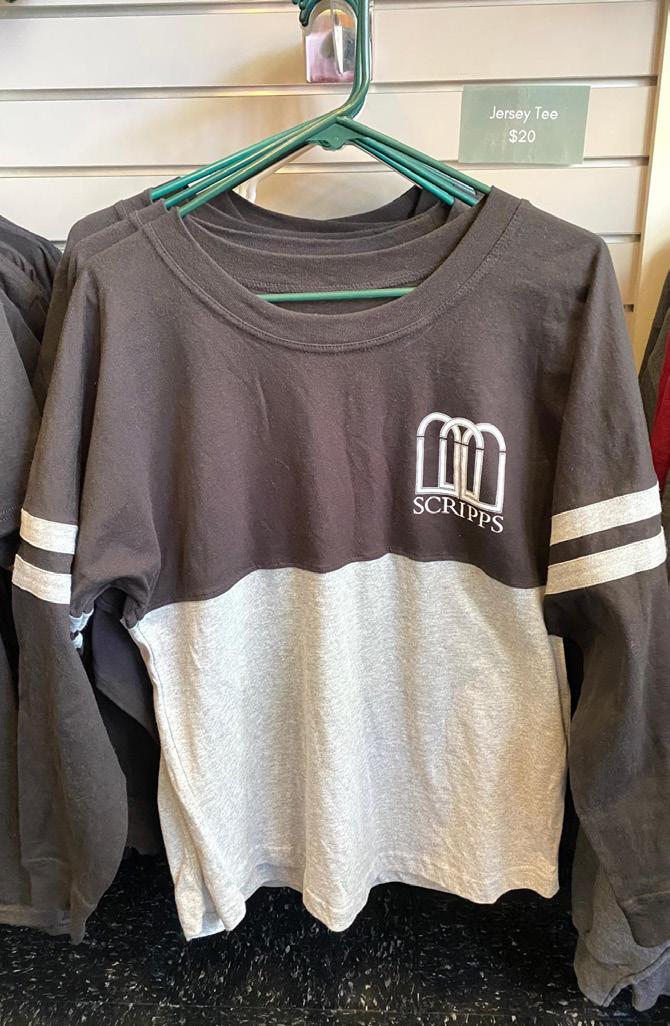
Rating: 9/10
Scripps College Squirrels ($14)
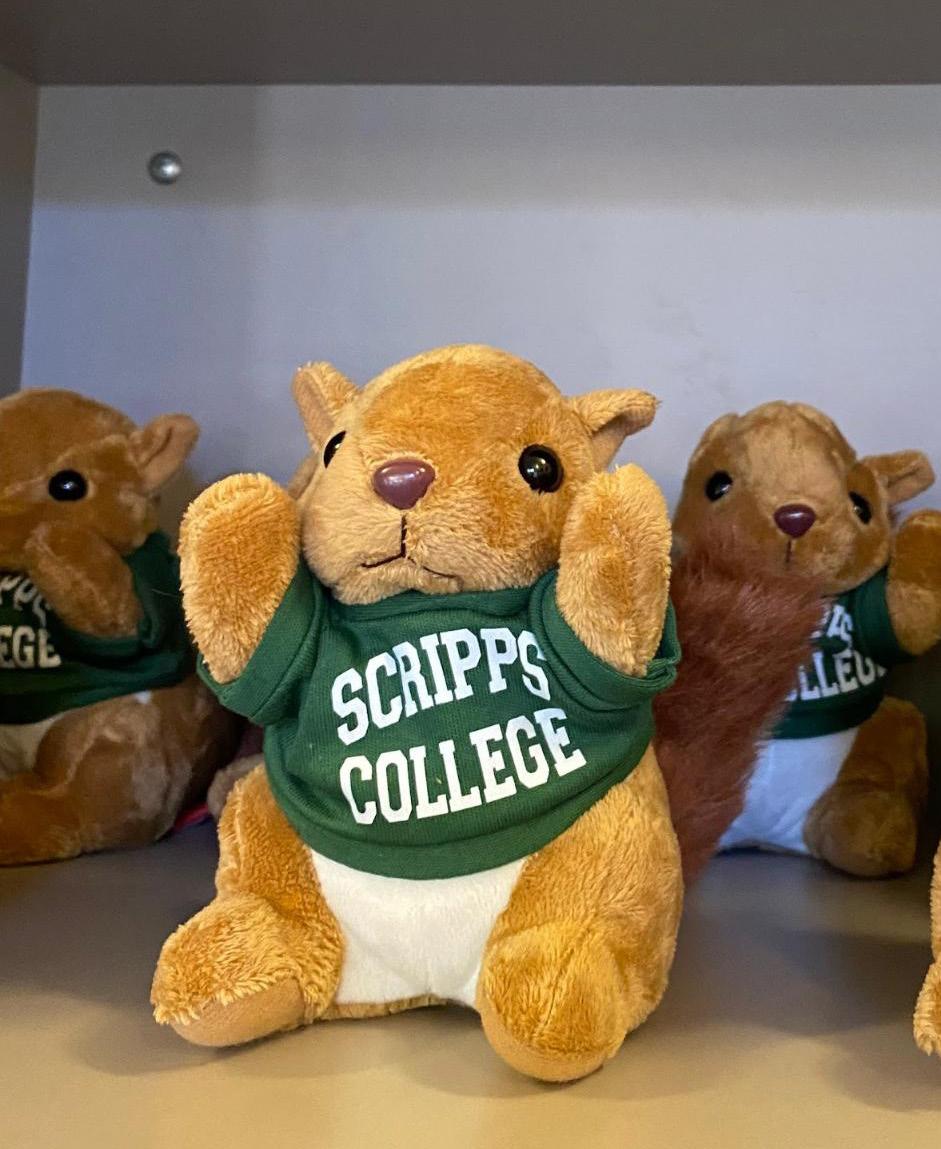
I’m such a big fan of these guys. Something about their cold, dead button eyes and the way they’re arranged on the shelf is just as adorably menacing as the real Claremont squirrels. Excellent job.
Rating: 11/10
Scripps College Desk Clock ($20)
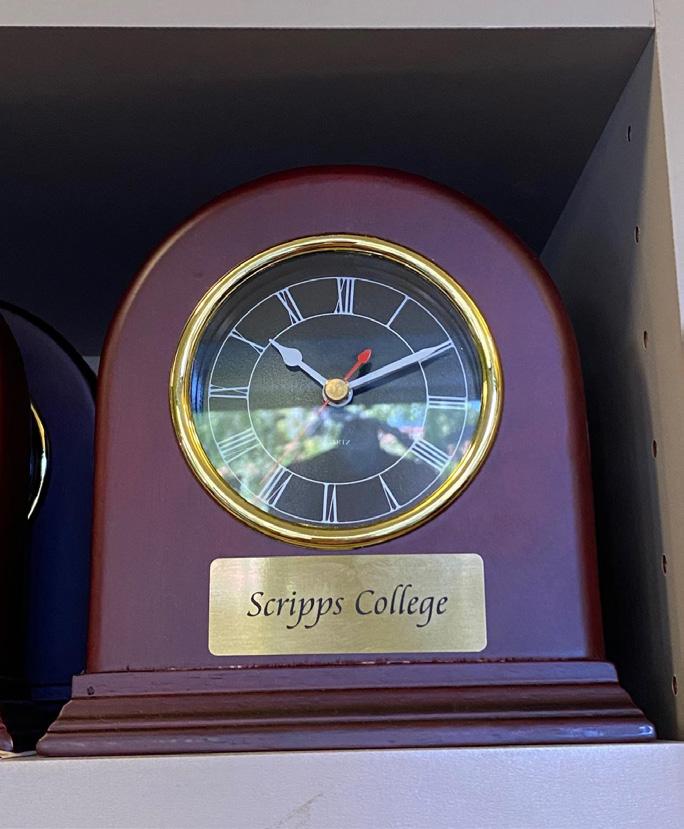
Why do we sell this? Was there actually a demand for Scrippsbranded roman numeral desk clocks? I really doubt it. “I have never sold one of those clocks,” said a source at The Scripps Store who wishes to remain anonymous.
Rating: 0/10
Scripps College Crewneck ($35)
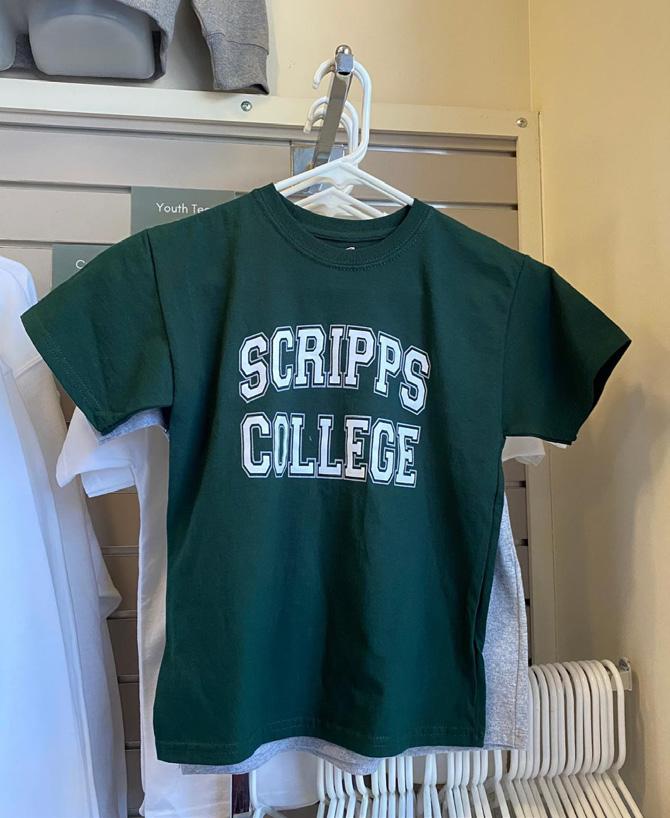
This is a great example of a classic college sweatshirt. Perfect for aspiring future students, alumni, and everyone in between. Yet, it also feels like it’s lacking the originality that seems so essential to the collective Scripps fashion sense. Despite the simplicity, it’s still a great sweatshirt, and it definitely gets bonus points for the tie-dye potential.
Rating: 8/10
Scripps College Long Sleeve Tee ($20)
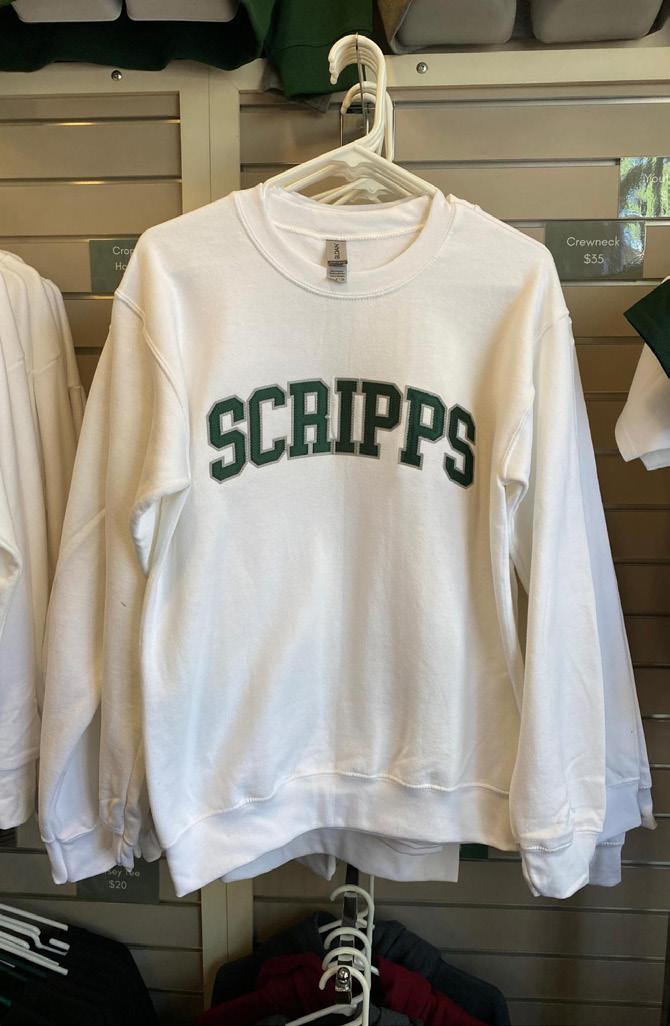
I really wanted to like this shirt. It’s a good basic and looks comfy. However, those sleeve stripes remind me a little too much of something that would be sold in the Justice store at my local mall. For that fact alone I cannot support it.
Rating: 4/10
Scripps College Graphic Mug ($12)

My mom has this mug. She loves it. I cannot speak to its popularity among consumers under the age of 50.
Rating: 7/10
Carabiners ($3)
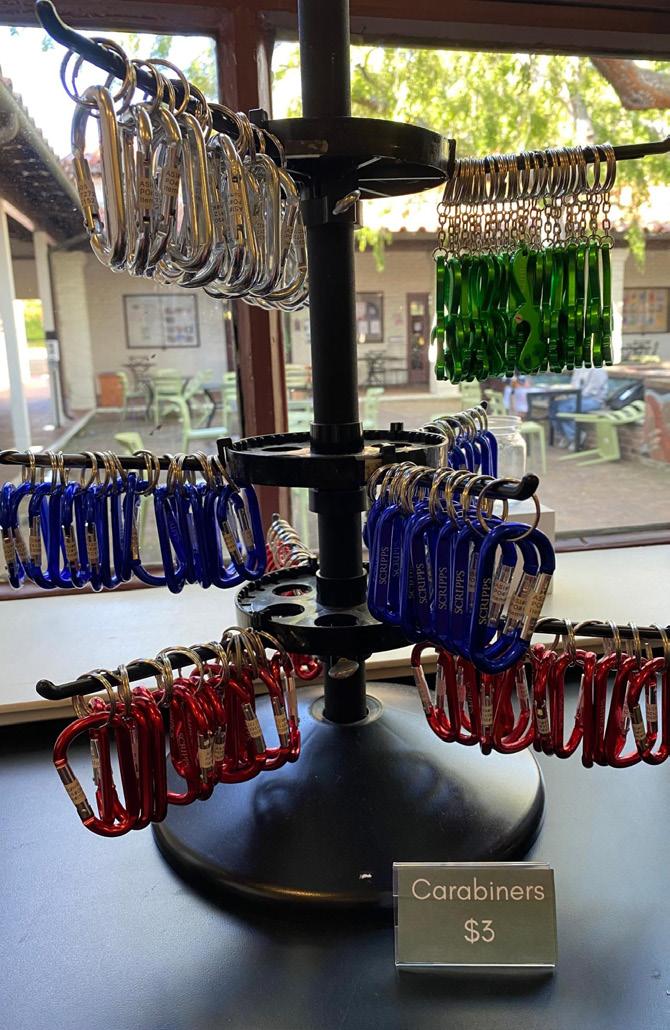
Yes. Yes, for many (many!!) reasons. Truly a Scripps College essential.
Rating: 12/10
Scripps Parent Quarter-Zip ($45)

Who doesn’t love a quarter-zip?
They are simple, cozy, and the gray and green go with everything. For every Scripps parent who’s been gifted this sweatshirt or bought it for themselves, you look lovely.
Rating: 10/10
Incipit Vita Nova Scripps Sweats
A controversial choice for The Scripps Store; I think you either love or hate the butt decal. Personally, I love it.
Rating: 9/10
Scripps College Shot Glass ($10)
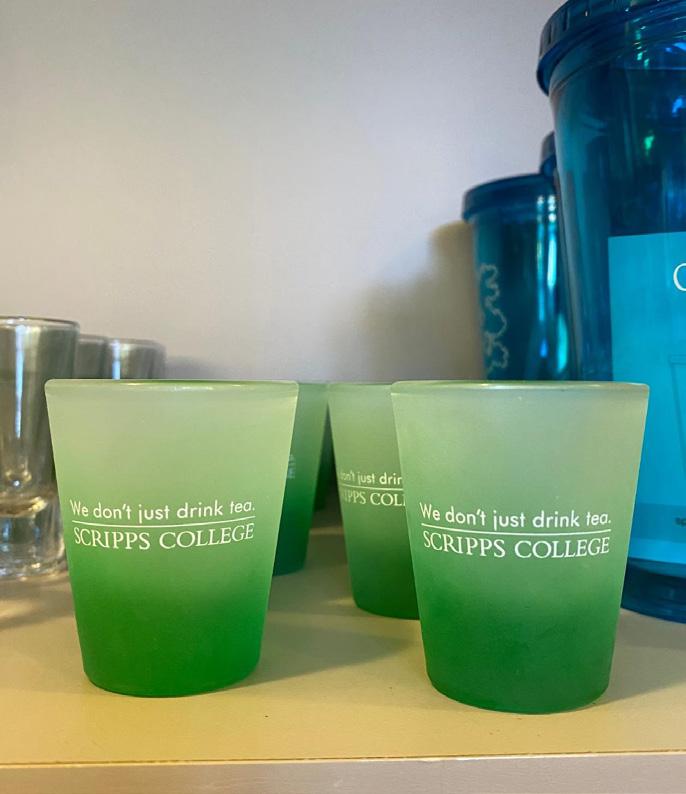
The fact that all of our shot glasses reference Wednesday Tea feels very appropriate
Rating: 10/10
Scripps College Signature Underwear
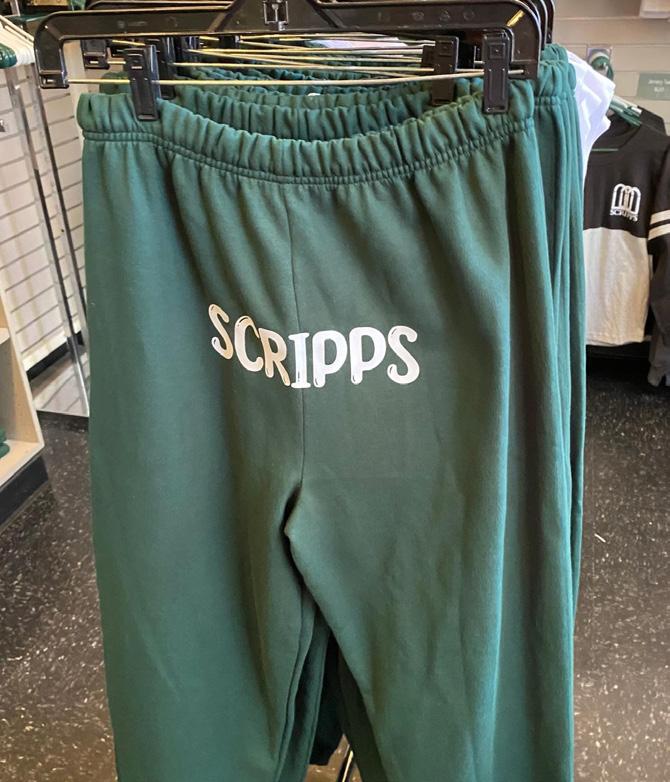
The Incipit Vita No Pants

Underwear: gone from The Scripps Store but in our hearts and memories forever. We can only hope that they’ll come back to us one day.
Rating: 100/10
Feature • 12
14 April 2023 • The Scripps Voice • Volume XXXI • Issue Seven









































